Dating Metasomatism: Monazite and Zircon Growth during Amphibolite Facies Albitization
Abstract
:1. Introduction
2. Geologic Background
2.1. Regional Geologic Setting
2.2. Local Rock Types
3. Albitite
3.1. Field Occurrence
3.2. Mineralogy and Mineral Compositions
3.3. Bulk Rock Composition
4. Monazite Morphology, Geochronology, and Geochemistry
4.1. Monazite Analytical Methods
4.2. Monazite Size, Morphology, Textural Context, and Compositional Zoning
4.3. Monazite U-Th Total Pb Results
4.4. Monazite Geochemistry
5. Zircon Morphology, Geochronology, and Geochemistry
5.1. Zircon Analytical Methods
5.2. Zircon Size, Morphology, Textural Context, and Compositional Zoning
5.2.1. Albitite Zircon
5.2.2. Other Orthogneiss Zircon Morphology
5.3. Zircon U-Pb Results
5.4. Zircon Trace Element and Thermometry Results
6. Discussion
6.1. Origin of the Albitite
6.2. Chemical Transformation to Albitite
6.3. Direct Dating Constraints on Albitization and Fluid Flow
6.4. Tectonic Significance of Metasomatism and Regional Fluid Flow
7. Conclusions
Author Contributions
Acknowledgments
Conflicts of Interest
Appendix
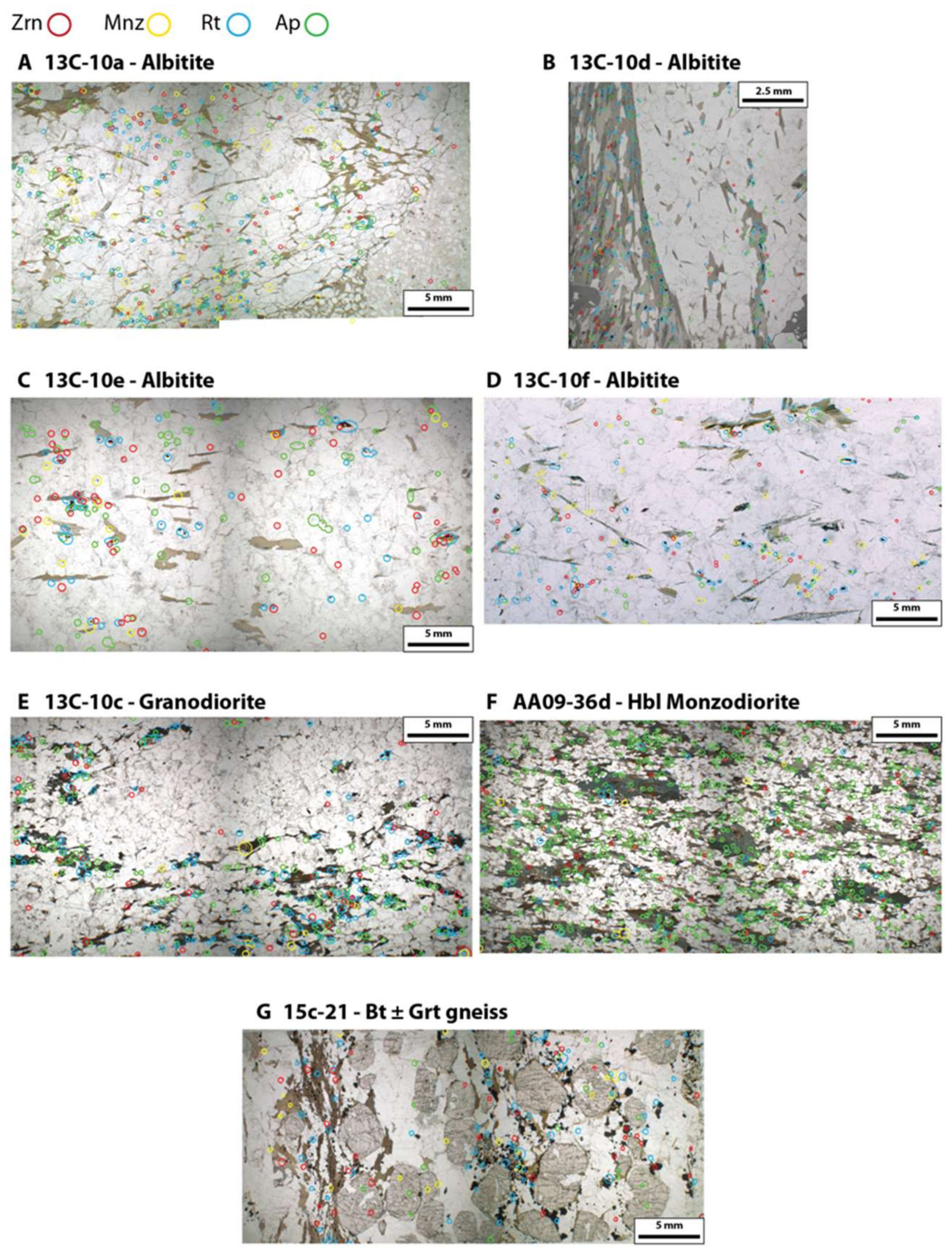
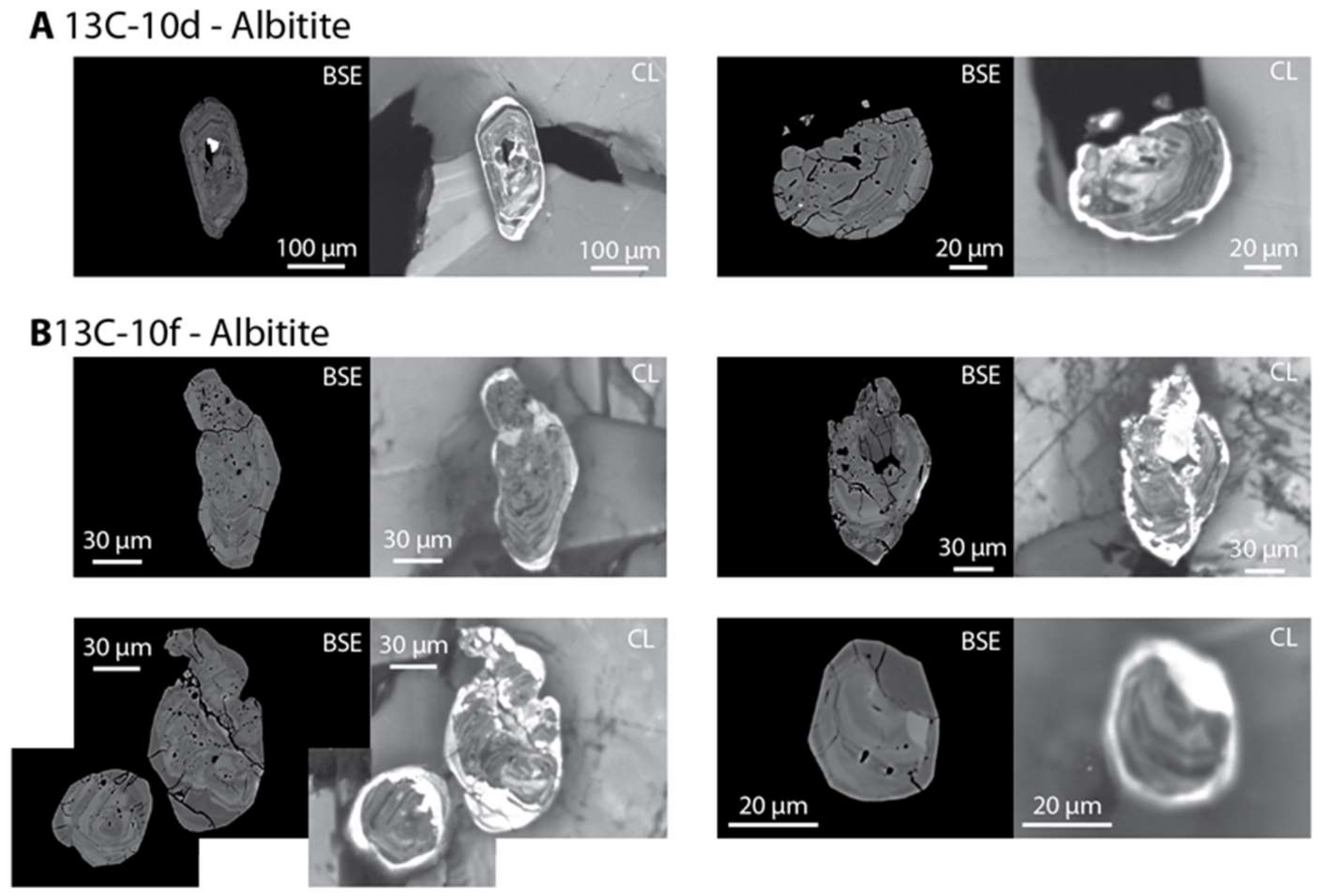
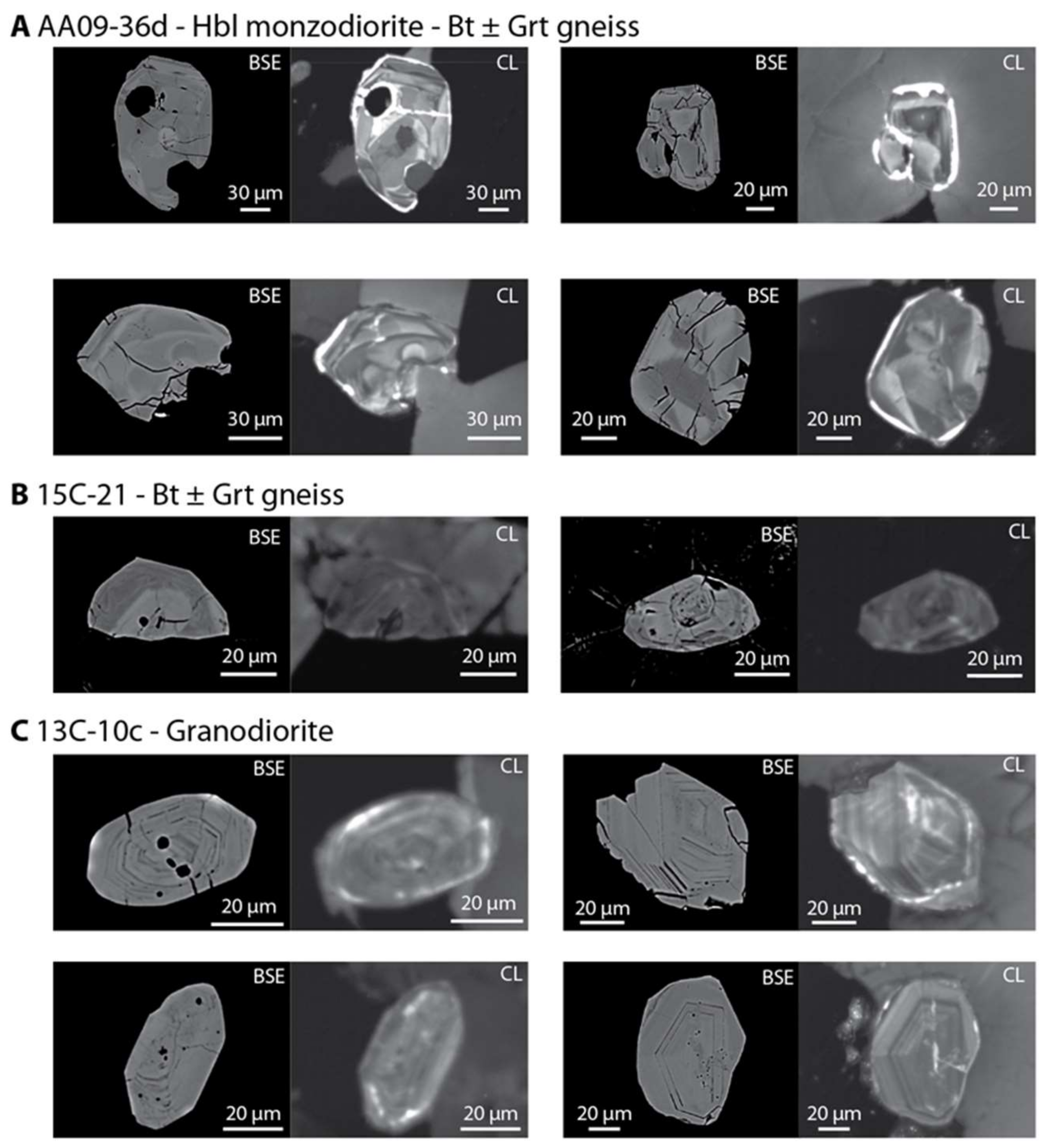
References
- Jamtveit, B.; Austrheim, H.; Putnis, A. Disequilibrium metamorphism of stressed lithosphere. Earth Sci. Rev. 2016, 154, 1–13. [Google Scholar] [CrossRef]
- Goncalves, P.; Oliot, E.; Marquer, D.; Connolly, J.A.D. Role of chemical processes on shear zone formation: An example from the Grimsel metagranodiorite (Aar massif, Central Alps). J. Metamorph. Geol. 2012, 30, 703–722. [Google Scholar] [CrossRef]
- Condit, C.B.; Mahan, K.H. Fracturing, fluid flow and shear zone development: Relationships between chemical and mechanical processes in Proterozoic mafic dykes from southwestern Montana, USA. J. Metamorph. Geol. 2018, 36, 195–223. [Google Scholar] [CrossRef]
- Penniston-Dorland, S.C.; Ferry, J.M. Element mobility and scale of mass transport in the formation of quartz veins during regional metamorphism of the Waits River Formation, east-central Vermont. Am. Mineral. 2008, 93, 7–21. [Google Scholar] [CrossRef]
- Ague, J.J. Mass-transfer during Barrovian metamorphism of pelites, south-central Connecticut I: Evidence for changes in composition and volume. Am. J. Sci. 1994, 294, 989–1057. [Google Scholar] [CrossRef]
- Jones, C.H.; Mahan, K.H.; Butcher, L.A.; Levandowski, W.B.; Farmer, G.L. Continental uplift through crustal hydration. Geology 2015, 43, 355–358. [Google Scholar] [CrossRef]
- Fischer, K.M. Waning buoyancy in the crustal roots of old mountains. Nature 2002, 417, 933–936. [Google Scholar] [CrossRef] [PubMed]
- Humphreys, E.; Hessler, E.; Dueker, K.; Farmer, G.L.; Erslev, E.; Atwater, T. How Laramide-Age Hydration of North American Lithosphere by the Farallon Slab Controlled Subsequent Activity in the Western United States. Int. Geol. Rev. 2003, 45, 575–595. [Google Scholar] [CrossRef]
- Breeding, C.M.; Ague, J.J. Slab-derived fluids and quartz-vein formation in an accretionary prism, Otago Schist, New Zealand. Geology 2002, 30, 499–502. [Google Scholar] [CrossRef]
- Audet, P.; Bürgmann, R. Possible control of subduction zone slow-earthquake periodicity by silica enrichment. Nature 2014, 510, 389–392. [Google Scholar] [CrossRef] [PubMed]
- Goncalves, P.; Marquer, D.; Oliot, E.; Durand, C. Thermodynamic Modeling and Thermobarometry of Metasomatized Rocks. In Metasomatism and Chemical Transformation of Rock; Harlov, D.E., Austrheim, H., Eds.; Springer: Berlin, Germany, 2013; pp. 53–92. ISBN 978-3-642-28393-2. [Google Scholar]
- Yardley, B. The Chemical Composition of Metasomatic Fluids in the Crust. In Metasomatism and the Chemical Transformation of Rock; Harlov, D.E., Austrheim, H., Eds.; Springer: Berlin, Germany, 2013; pp. 17–51. [Google Scholar]
- Villa, I.M.; Williams, M.L. Geochronology of Metasomatic Events. In Metasomatism and the Chemical Transformation of Rock SE—8; Springer: Berlin, Germany, 2013; pp. 171–202. ISBN 978-3-642-28393-2. [Google Scholar]
- Mahan, K.H.; Goncalves, P.; Williams, M.L.; Jercinovic, M.J. Dating metamorphic reactions and fluid flow: Application to exhumation of high-P granulites in a crustal-scale shear zone, western Canadian Shield. J. Metamorph. Geol. 2006, 24, 193–217. [Google Scholar] [CrossRef]
- Butcher, L.; Mahan, K.H.; Allaz, J.M. Late Cretaceous crustal hydration in the Colorado Plateau, USA, from xenolith petrology and monazite geochronology. Lithosphere 2017, 9, 561–578. [Google Scholar] [CrossRef]
- Rubatto, D.; Angiboust, S. Oxygen isotope record of oceanic and high pressure metasomatism: A P-T-time-fluid path for the Monviso eclogite (Italy). Cont. Min. Pet. 2015, 170. [Google Scholar] [CrossRef]
- Engvik, A.K.; Putnis, A.; Fitz Gerald, J.D.; Austrheim, H. Albitization of granitic rocks: The mechanism of replacement of oligoclase by albite. Can. Mineral. 2008, 46, 1401–1415. [Google Scholar] [CrossRef]
- Petersson, J.; Stephens, M.B.; Mattsson, H.; Möller, C. Albitization and quartz dissolution in Paleoproterozoic metagranite, central Sweden-Implications for the disposal of spent nuclear fuel in a deep geological repository. Lithos 2012, 148, 10–26. [Google Scholar] [CrossRef]
- Touret, J.; Nijland, T. Prograde, Peak and Retrograde Metamorphic Fluids and Associated Metasomatism in Upper Amphibolite to Granulite Facies Transition Zones. In Metasomatism and the Chemical Transformation of Rock; Harlov, D.E., Austrheim, H., Eds.; Springer: Berlin, Germany, 2013; pp. 415–469. ISBN 978-3-642-28393-2. [Google Scholar]
- Condit, C.B.; Mahan, K.H.; Ault, A.K.; Flowers, R.M. Foreland-directed propagation of high-grade tectonism in the deep roots of a Paleoproterozoic collisional orogen, SW Montana, USA. Lithosphere 2015, 7, 625–645. [Google Scholar] [CrossRef]
- Mueller, P.A.; Burger, H.R.; Wooden, J.L.; Heatherington, A.L.; Mogk, D.W.; D’Arcy, K. Age and evolution of the Precambrian Crust of the Tobacco Root Mountains, Montana. Geol. Soc. Am. Spec. Pap. 2004, 377, 181–202. [Google Scholar]
- Harms, T.A.; Brady, J.B.; Burger, H.R.; Cheney, J.T. Advances in the geology of the Tobacco Root Mountains, Montana and their implications for the history of the northern Wyoming province. Geol. Soc. Am. Spec. Pap. 2004, 377, 227–243. [Google Scholar]
- Mueller, P.A.; Burger, H.R.; Wooden, J.L.; Brady, J.B.; Cheney, J.T.; Harms, T.A.; Heatherington, A.L.; Mogk, D.W. Paleoproterozoic Metamorphism in the Northern Wyoming Province: Implications for the Assembly of Laurentia. J. Geol. 2005, 113, 169–179. [Google Scholar] [CrossRef]
- Cheney, J.; Brady, J. Proterozoic metamorphism of the Tobacco Root Mountains, Montana. Geol. Soc. Am. Spec. Pap. 2004, 377, 105–129. [Google Scholar]
- Krogh, T.E.; Kamo, S.L.; Hanley, T.B.; Hess, D.F.; Dahl, P.S.; Johnson, R.E. Geochronology and geochemistry of Precambrian gneisses, metabasites, and pegmatite from the Tobacco Root Mountains, northwestern Wyoming craton, Montana. Can. J. Earth Sci. 2011, 48, 161–185. [Google Scholar] [CrossRef]
- Cheney, J.; Webb, A.; Coath, C.; McKeegan, K. In situ ion microprobe 207Pb/206Pb dating of monazite from Precambrian metamorphic suites, Tobacco Root Mountains, Montana. Geol. Soc. Am. Spec. Pap. 2004, 377, 151–179. [Google Scholar] [CrossRef]
- Mueller, P.A.; Wooden, J.L.; Mogk, D.W.; Foster, D.A. Paleoproterozoic evolution of the Farmington zone: Implications for terrane accretion in southwestern Laurentia. Lithosphere 2011, 3, 401–408. [Google Scholar] [CrossRef]
- Foster, D.A.; Mueller, P.A.; Mogk, D.W.; Wooden, J.L.; Vogl, J.J. Proterozoic evolution of the western margin of the Wyoming craton: Implications for the tectonic and magmatic evolution of the northern Rocky. Can. J. Earth Sci. 2006, 43, 1601–1619. [Google Scholar] [CrossRef]
- Whitmeyer, S.; Karlstrom, K. Tectonic model for the Proterozoic growth of North America. Geosphere 2007. [Google Scholar] [CrossRef]
- Giletti, B. Isotopic ages from southwestern Montana. J. Geophys. Res. 1966, 71, 4029–4036. [Google Scholar] [CrossRef]
- Giletti, B. Discordant isotopic ages and excess argon in biotites. Earth Planet. Sci. Lett. 1971, 10, 157–164. [Google Scholar] [CrossRef]
- Hames, W.E.; Harms, T.A. Laser 40Ar/39Ar thermochronology of single crystals from Paleoproterozoic and Archean rocks of the norther Wyoming Province, Big Sky orogen, and Great Falls Tectonic Zone: Giletti’s Line revisted. In Proceedings of the GSA’s 125th Anniversary Annual Meeting & Exposition, Denver, CO, USA, 27–30 October 2013. [Google Scholar]
- Salt, K.J. Archean Geology of the Spanish Peaks Area, Southwestern Montana, Montana State University. Master Thesis, Montana State University, Bozeman, MT, USA, March 1987. [Google Scholar]
- Weyand, E.L. U-Pb Zircon geochronology of Archean Rocks from the Spanish Peaks area, Madison Range. Master’s Thesis, Univeristy Of Florida, Gainesville, FL, USA, 1989. [Google Scholar]
- Spencer, E.; Kozak, S. Precambrian evolution of the Spanish Peaks area, Montana. Geol. Soc. Am. Bull. 1975, 86, 785–792. [Google Scholar] [CrossRef]
- Ault, A.K.; Flowers, R.M.; Mahan, K.H. Quartz shielding of sub-10μm zircons from radiation damage-enhanced Pb loss: An example from a metamorphosed mafic dike, northwestern Wyoming craton. Earth Planet. Sci. Lett. 2012, 339–340, 57–66. [Google Scholar] [CrossRef]
- Whitney, D.L.; Evans, B.W. Abbreviations for names of rock-forming minerals. Am. Mineral. 2009, 95, 185–187. [Google Scholar] [CrossRef]
- Mogk, D.W.; Mueller, P.A.; Wooden, J.L. The nature of Archean terrane boundaries: An example from the northern Wyoming Province. Precambrian Res. 1992, 55, 155–168. [Google Scholar] [CrossRef]
- McDonough, W.F.; Sun, S.S. The composition of the Earth. Chem. Geol. 1995, 120, 223–253. [Google Scholar] [CrossRef]
- Dumond, G.; Mclean, N.; Williams, M.; Jercinovic, M.; Bowring, S. High-resolution dating of granite petrogenesis and deformation in a lower crustal shear zone: Athabasca granulite terrane, western Canadian Shield. Chem. Geol. 2008, 254, 175–196. [Google Scholar] [CrossRef]
- Williams, M.L.; Jercinovic, M.J.; Goncalves, P.; Mahan, K. Format and philosophy for collecting, compiling, and reporting microprobe monazite ages. Chem. Geol. 2006, 225, 1–15. [Google Scholar] [CrossRef]
- Jercinovic, M.; Williams, M.; Lane, E. In-situ trace element analysis of monazite and other fine-grained accessory minerals by EPMA. Chem. Geol. 2008, 254, 197–215. [Google Scholar] [CrossRef]
- Allaz, J.M.; Williams, M.L.; Jercinovic, M.J.; Donavan, J. A new technique for electron microprobe trace element analysis: The multipoint background method. In Proceedings of the EMAS Annual Meeting, Angers, France, 15–19 May 2011; pp. 319–320. [Google Scholar]
- Davis, W.J. (Geological Survey of Canada). Personal communication, 2007. [Google Scholar]
- Allaz, J.M. (ETH, Zurich, Switzerland). Personal communication, 2015. [Google Scholar]
- Jackson, S.E.; Pearson, N.J.; Griffin, W.L.; Belousova, E.A. The application of laser ablation-in ductively coupled plasma-mass spectrometry to in situ U-Pb zircon geochronology. Chem. Geol. 2004, 211, 47–69. [Google Scholar] [CrossRef]
- Jochum, K.P.; Weis, U.; Stoll, B.; Kuzmin, D.; Yang, Q.; Raczek, I.; Jacob, D.E.; Stracke, A.; Birbaum, K.; Frick, D.A.; et al. Determination of reference values for NIST SRM 610-617 glasses following ISO guidelines. Geostand. Geoanal. Res. 2011, 35, 397–429. [Google Scholar] [CrossRef]
- Sláma, J.; Košler, J.; Condon, D.J.; Crowley, J.L.; Gerdes, A.; Hanchar, J.M.; Horstwood, M.S.A.; Morris, G.A.; Nasdala, L.; Norberg, N.; et al. Plešovice zircon—A new natural reference material for U–Pb and Hf isotopic microanalysis. Chem. Geol. 2008, 249, 1–35. [Google Scholar] [CrossRef]
- Paton, C.; Woodhead, J.D.; Hellstrom, J.C.; Hergt, J.M.; Greig, A.; Maas, R. Improved laser ablation U–Pb zircon geochronology through robust downhole fractionation correction. Geochem. Geophys. Geosyst. 2010, 11. [Google Scholar] [CrossRef]
- Paton, C.; Hellstrom, J.; Paul, B.; Woodhead, J.; Hergt, J. Iolite: Freeware for the visualisation and processing of mass spectrometric data. J. Anal. At. Spectrom. 2011, 26, 2508. [Google Scholar] [CrossRef]
- Petrus, J.A.; Kamber, B.S. VizualAge: A Novel Approach to Laser Ablation ICP-MS U-Pb Geochronology Data Reduction. Geostand. Geoanal. Res. 2012, 36, 247–270. [Google Scholar] [CrossRef]
- Watson, E.B.; Wark, D.A.; Thomas, J.B. Crystallization thermometers for zircon and rutile. Contrib. Mineral. Petrol. 2006, 151, 413–433. [Google Scholar] [CrossRef]
- Fu, B.; Page, F.Z.; Cavosie, A.J.; Fournelle, J.; Kita, N.T.; Lackey, J.S.; Wilde, S.A.; Valley, J.W. Ti-in-zircon thermometry: Applications and limitations. Contrib. Mineral. Petrol. 2008, 156, 197–215. [Google Scholar] [CrossRef]
- Pin, C.; Monchoux, P.; Paquette, J.L.; Azambre, B.; Wang, R.C.; Martin, R.F. Igneous albitite dikes in orogenic lherzolites, western Pyrénées, France: A possible source for corundum and alkali feldspar xenocrysts in basaltic terranes. II. Geochemical and petrogenetic considerations. Can. Mineral. 2006, 44, 843–856. [Google Scholar] [CrossRef]
- Nédélec, A.; Minyem, D.; Barbey, P. High-P-high-T anatexis of Archaean tonalitic grey gneisses: The Eseka migmatites, Cameroon. Precambr. Res. 1993, 62, 191–205. [Google Scholar] [CrossRef]
- Thompson, A.B. Dehydration melting of pelitic rocks and the generation of H2O-undersaturated granitic liquids. Am. J. Sci. 1982, 282, 1567–1595. [Google Scholar] [CrossRef]
- Rubenach, M.J.; Lewthwaite, K.A. Metasomatic albitites and related biotite-rich schists from a low-pressure polymetamorphic terrane, Snake Creek Anticline, Mount Isa Inlier, North-Eastern Australia: Microstructures and P-T-d paths. J. Metamorph. Geol. 2002, 20, 191–202. [Google Scholar] [CrossRef]
- Engvik, A.K.; Ihlen, P.M.; Austrheim, H. Characterisation of Na-metasomatism in the Sveconorwegian Bamble Sector of South Norway. Geosci. Front. 2014, 5, 659–672. [Google Scholar] [CrossRef]
- Boulvais, P.; Ruffet, G.; Cornichet, J.; Mermet, M. Cretaceous albitization and dequartzification of Hercynian peraluminous granite in the Salvezines Massif (French Pyrenees). Lithos 2007, 93, 89–106. [Google Scholar] [CrossRef]
- Deer, W.; Howie, R.; Zussman, J. The Rock Forming Minerals, 2nd ed.; Pearson Education Limited: London, UK, 1992. [Google Scholar]
- Tobisch, O.T.; McNully, B.A.; Vernon, R.H. Microgranitoid enclave swarms in granitic pluton, central Sierra Nevada, California. Lithos 1997, 40, 321–339. [Google Scholar] [CrossRef]
- Corfu, F.; Hanchar, J.M.; Hoskin, P.W.; Kinny, P. Atlas of Zircon Textures. Rev. Mineral. Geochem. 2003, 53, 469–500. [Google Scholar] [CrossRef]
- Grant, J.A. The isocon diagram; a simple solution to Gresens’ equation for metasomatic alteration. Econ. Geol. 1986, 81, 1976–1982. [Google Scholar] [CrossRef]
- Grant, M.L.; Wilde, S.A.; Wu, F.; Yang, J. The application of zircon cathodoluminescence imaging, Th–U–Pb chemistry and U–Pb ages in interpreting discrete magmatic and high-grade metamorphic events in the North China Craton at the Archean/Proterozoic boundary. Chem. Geol. 2009, 261, 155–171. [Google Scholar] [CrossRef]
- Kaur, P.; Chaudhri, N.; Hofmann, A.W. New evidence for two sharp replacement fronts during albitization of granitoids from northern Aravalli orogen, northwest India. Int. Geol. Rev. 2015, 57, 1660–1685. [Google Scholar] [CrossRef]
- Jaguin, J.; Boulvais, P.; Poujol, M.; Bosse, V.; Paquette, J.L.; Vilbert, D. Albitization in the Antimony Line, Murchison Greenstone Belt (Kaapvaal Craton): A geochemical and geochronological investigation. Lithos 2013, 168–169, 124–143. [Google Scholar] [CrossRef]
- Geisler, T.; Schaltegger, U.; Tomaschek, F. Re-equilibration of zircon in aqueous fluids and melts. Elements 2007, 3, 43–50. [Google Scholar] [CrossRef]
- Petrík, I.; Konečný, P. Metasomatic replacement of inherited metamorphic monazite in a biotite-garnet granite from the Nízke Tatry Mountains, Western Carpathians, Slovakia: Chemical dating and evidence for disequilibrium melting. Am. Mineral. 2009, 94, 957–974. [Google Scholar] [CrossRef]
- Harlov, D.E.; Dunkley, D.J. Experimental high-grade alteration of zircon using alkali- and Ca-bearing solutions. Am. Mineral. 2011, 96, 716–731. [Google Scholar] [CrossRef]
- Harlov, D.E.; Hetherington, C.J. Partial high-grade alteration of monazite using alkali-bearing fluids: Experiment and nature. Am. Mineral. 2010, 95, 1105–1108. [Google Scholar] [CrossRef]
- Williams, M.L.; Jercinovic, M.J.; Harlov, D.E.; Budzyń, B.; Hetherington, C.J. Resetting monazite ages during fluid-related alteration. Chem. Geol. 2011, 283, 218–225. [Google Scholar] [CrossRef]
- Hetherington, C.J.; Harlov, D.E.; Budzyń, B. Experimental metasomatism of monazite and xenotime: Mineral stability, REE mobility and fluid composition. Mineral. Petrol. 2010, 99, 165–184. [Google Scholar] [CrossRef]
- Hurai, V.; Paquette, J.L.; Lexa, O.; Konečný, P.; Dianiška, I. U-Pb-Th geochronology of monazite and zircon in albitite metasomatites of the Rožňava-Nadabula ore field (Western Carpathians, Slovakia): Implications for the origin of hydrothermal polymetallic siderite veins. Mineral. Petrol. 2015, 109, 519–530. [Google Scholar] [CrossRef]
- Putnis, A. Mineral Replacement Reactions. Rev. Mineral. Geochem. 2009, 70, 87–124. [Google Scholar] [CrossRef]
- Putnis, A. Mineral replacement reactions: From macroscopic observations to microscopic mechanisms. Mineral. Mag. 2002, 66, 689–708. [Google Scholar] [CrossRef]
- Tomaschek, F. Zircons from Syros, Cyclades, Greece-Recrystallization and Mobilization of Zircon During High-Pressure Metamorphism. J. Petrol. 2003, 44, 1977–2002. [Google Scholar] [CrossRef]
- Taylor, R.J.M.; Clark, C.; Fitzsimons, I.C.W.; Santosh, M.; Hand, M.; Evans, N.; McDonald, B. Post-peak, fluid-mediated modification of granulite facies zircon and monazite in the Trivandrum Block, southern India. Contrib. Mineral. Petrol. 2014, 168, 1–17. [Google Scholar] [CrossRef]
- Taylor, R.J.M.; Kirkland, C.L.; Clark, C. Accessories after the facts: Constraining the timing, duration and conditions of high-temperature metamorphic processes. Lithos 2016, 264, 239–257. [Google Scholar] [CrossRef]
- Peterman, E.M.; Snoeyenbos, D.R.; Jercinovic, M.J.; Kylander-Clark, A. Dissolution-reprecipitation metasomatism and growth of zircon within phosphatic garnet in metapelites from western Massachusetts. Am. Mineral. 2016, 101, 1792–1806. [Google Scholar] [CrossRef]
- Soman, A.; Geisler, T.; Tomaschek, F.; Grange, M.; Berndt, J. Alteration of crystalline zircon solid solutions: A case study on zircon from an alkaline pegmatite from Zomba-Malosa, Malawi. Contrib. Mineral. Petrol. 2010, 160, 909–930. [Google Scholar] [CrossRef]
- Yardley, B.W.D.; Graham, J.T. The origins of salinity in metamorphic fluids. Geofluids 2002, 2, 249–256. [Google Scholar] [CrossRef]
- Burger, H.; Peck, W.; Johnson, K.; Tierney, K.; Pouslen, C.; Cady, P.; Lowell, J.; MacFarlane, W.; Sincock, M.; Archuleta, L.; et al. Geology and geochemistry of the Spuhler Peak Metamorphic Suite. Geol. Soc. Am. Spec. Pap. 2004, 377, 47–70. [Google Scholar] [CrossRef]
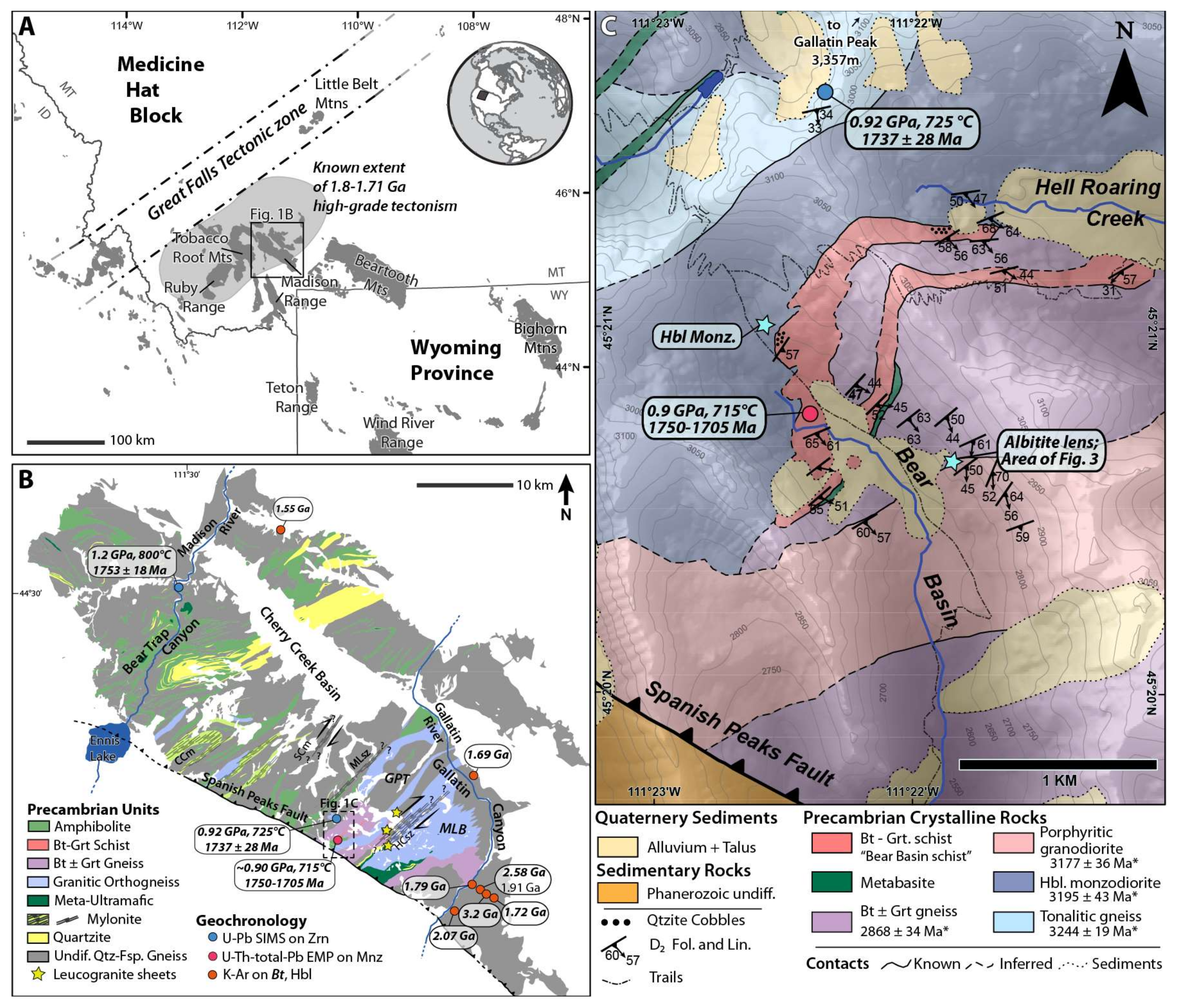
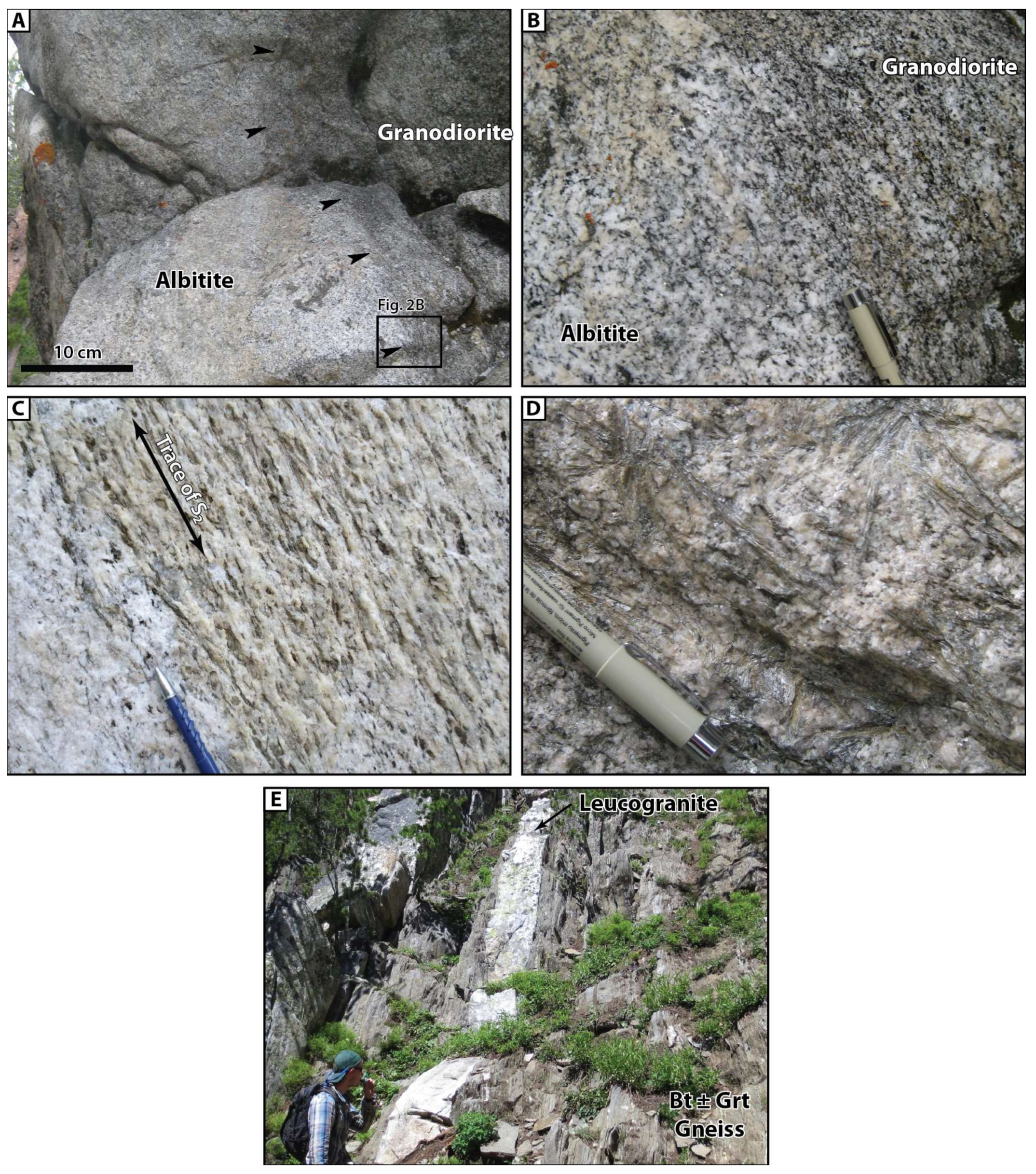
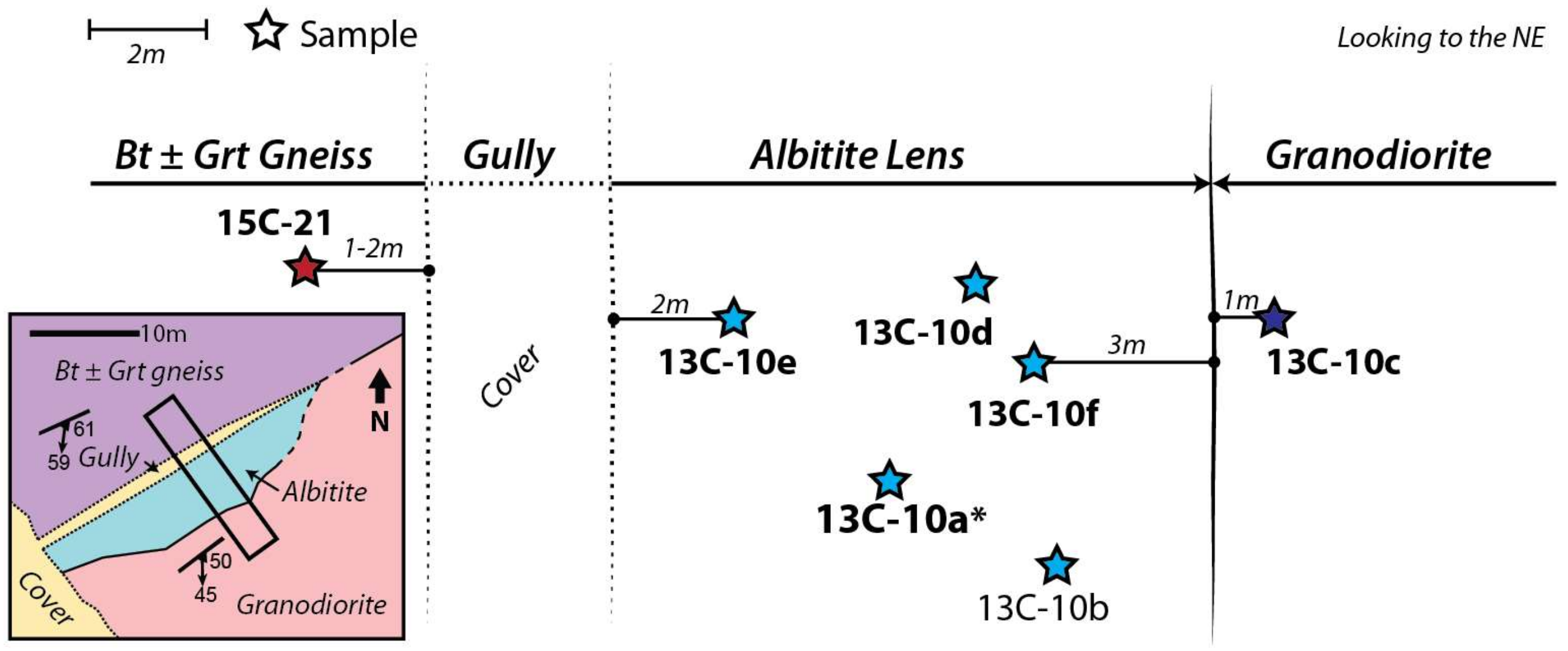
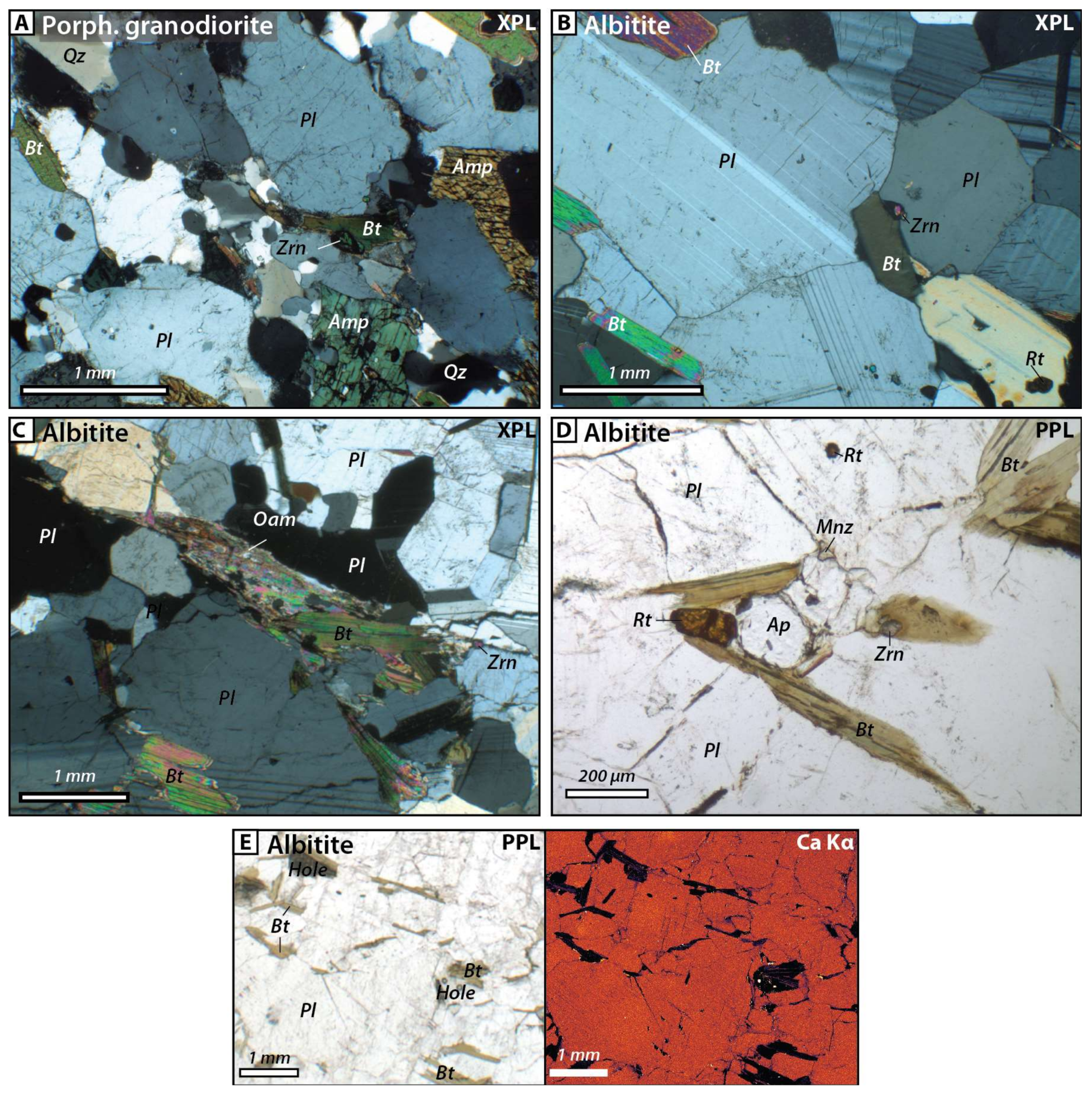
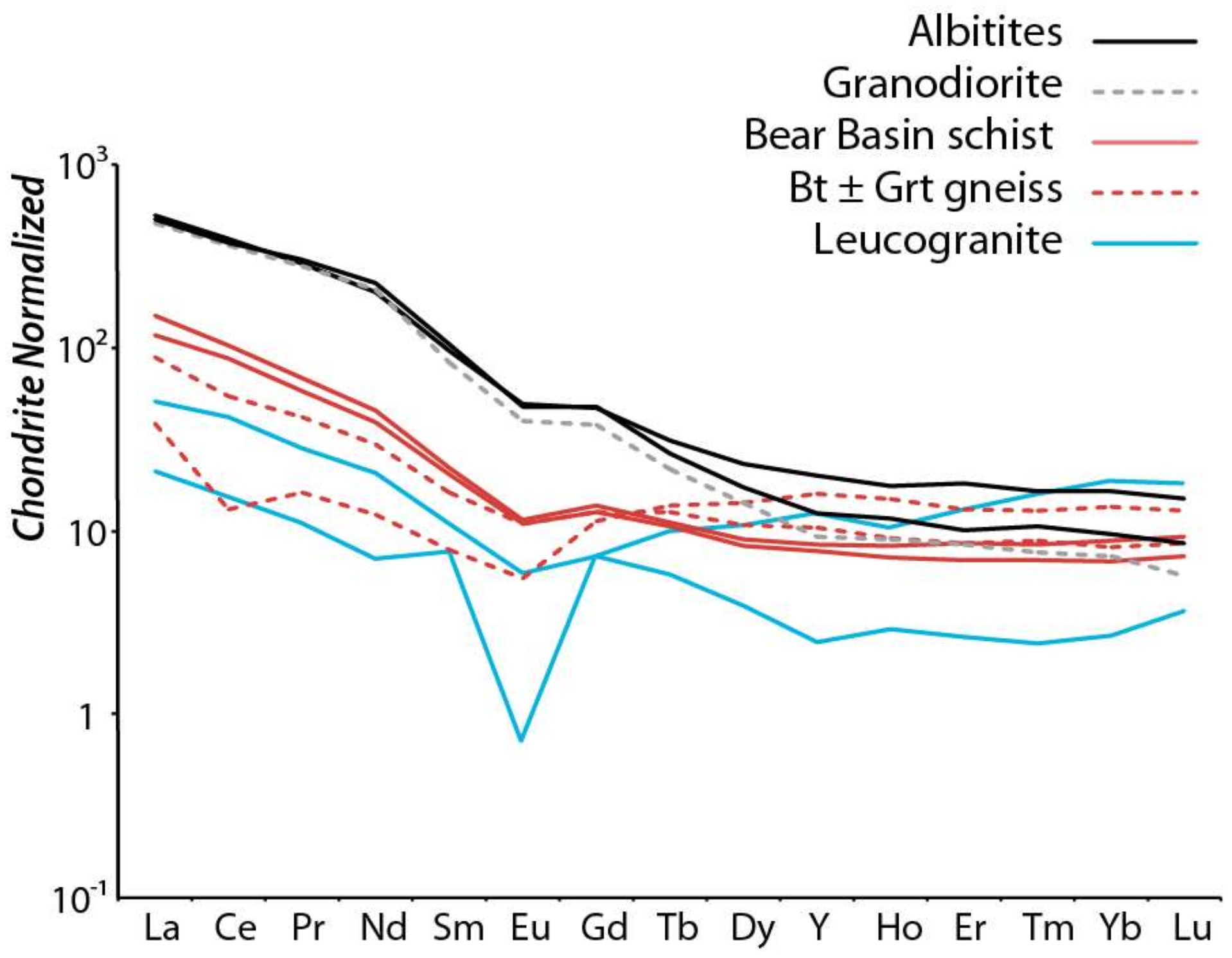
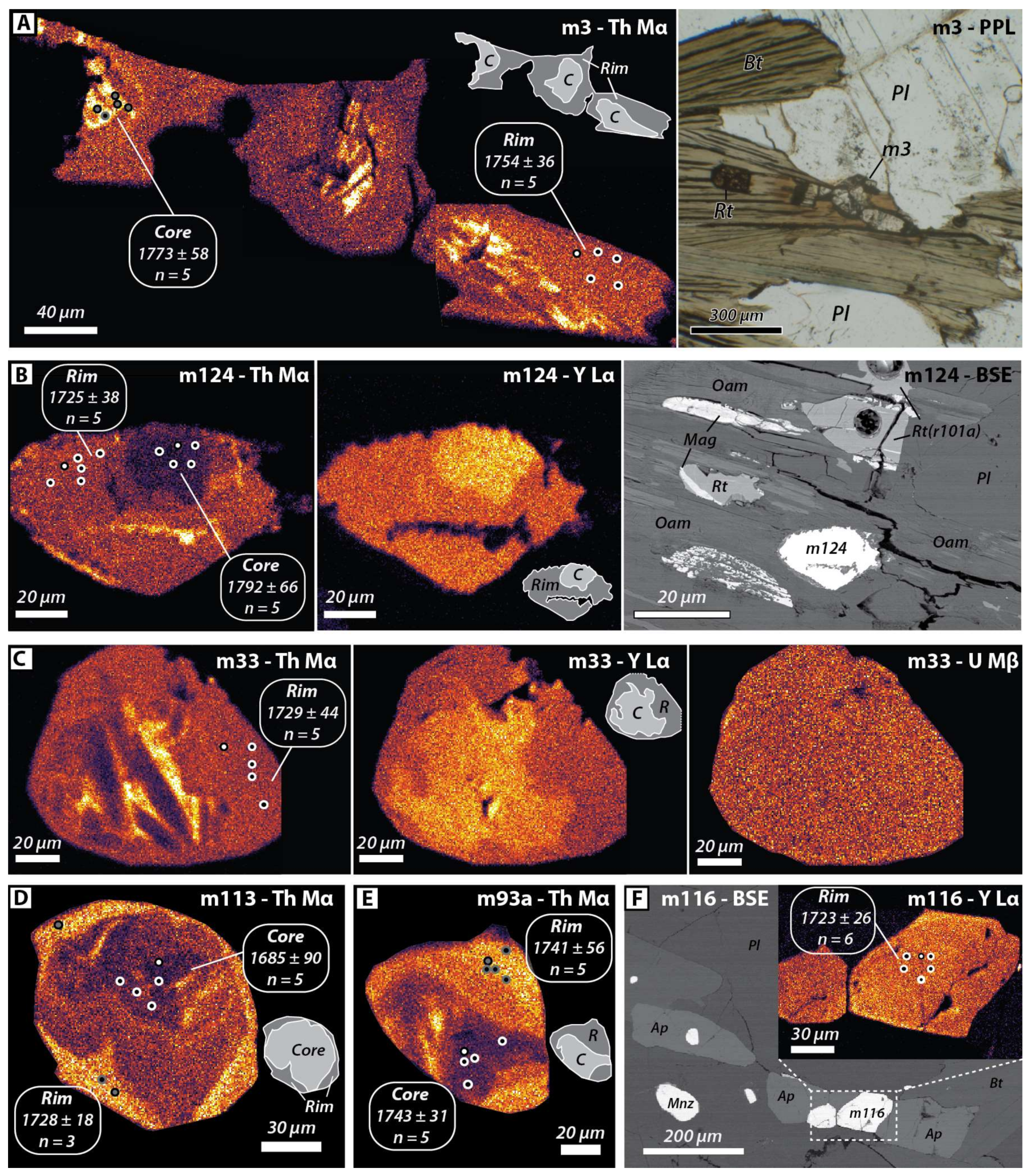
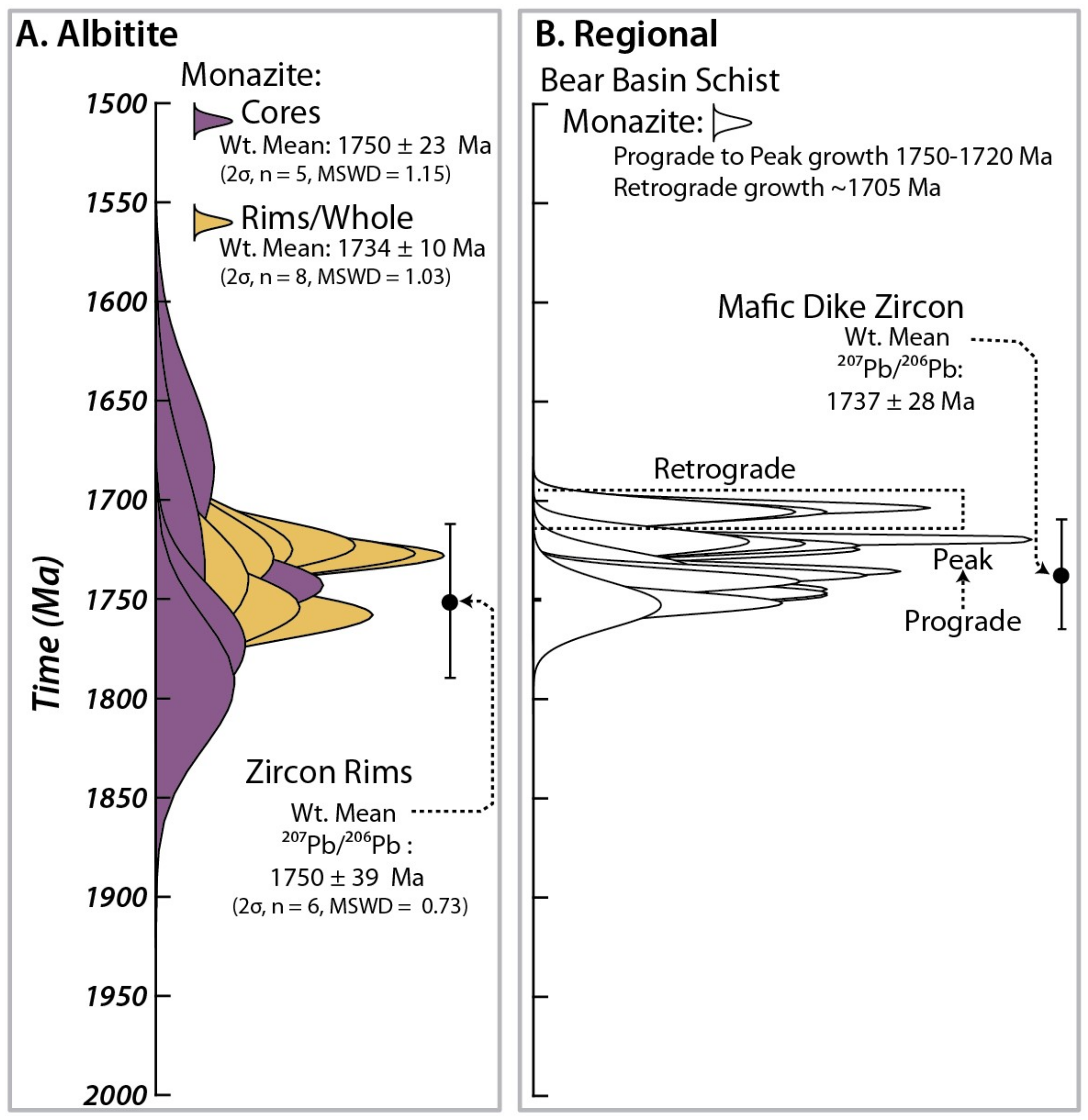
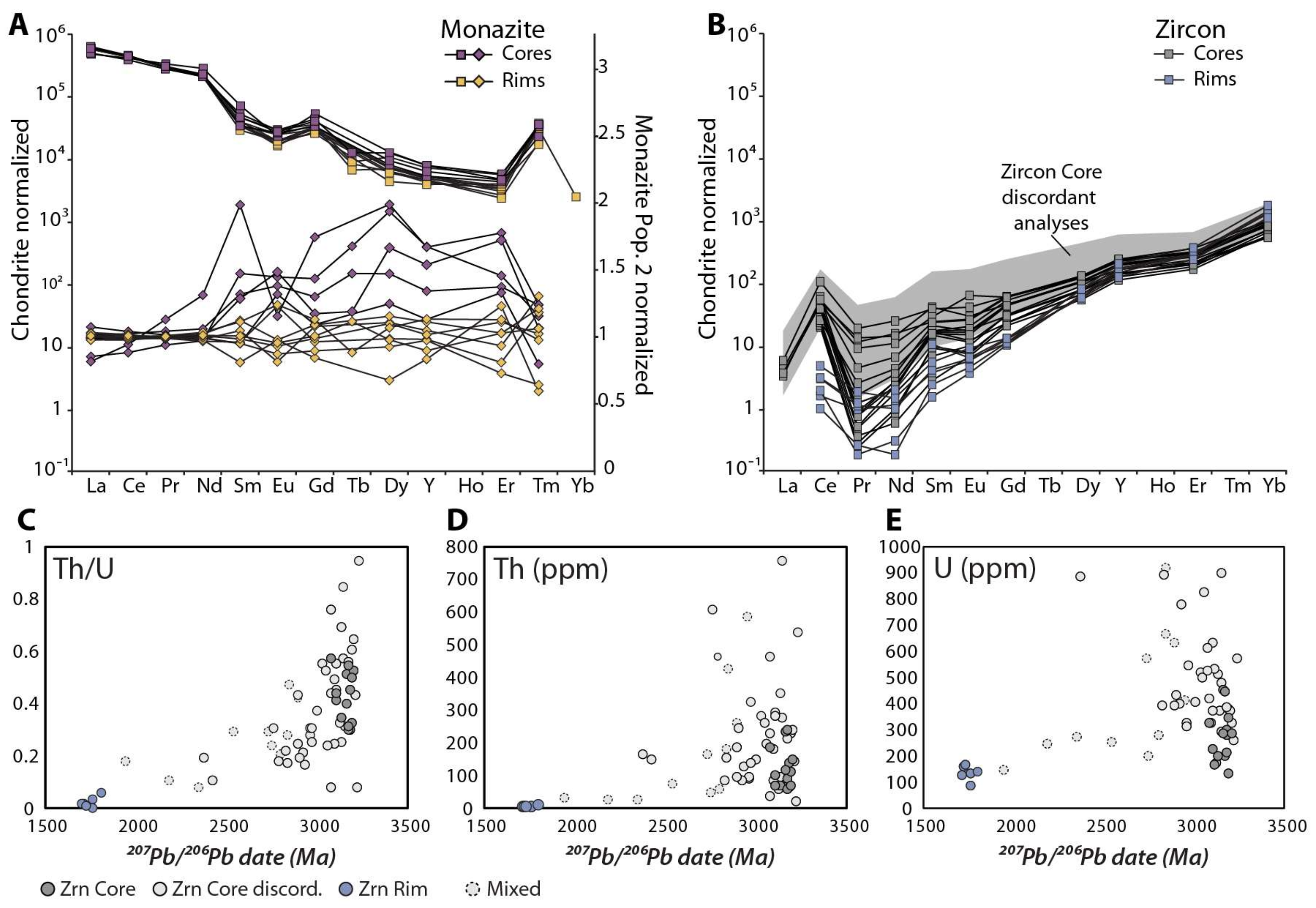
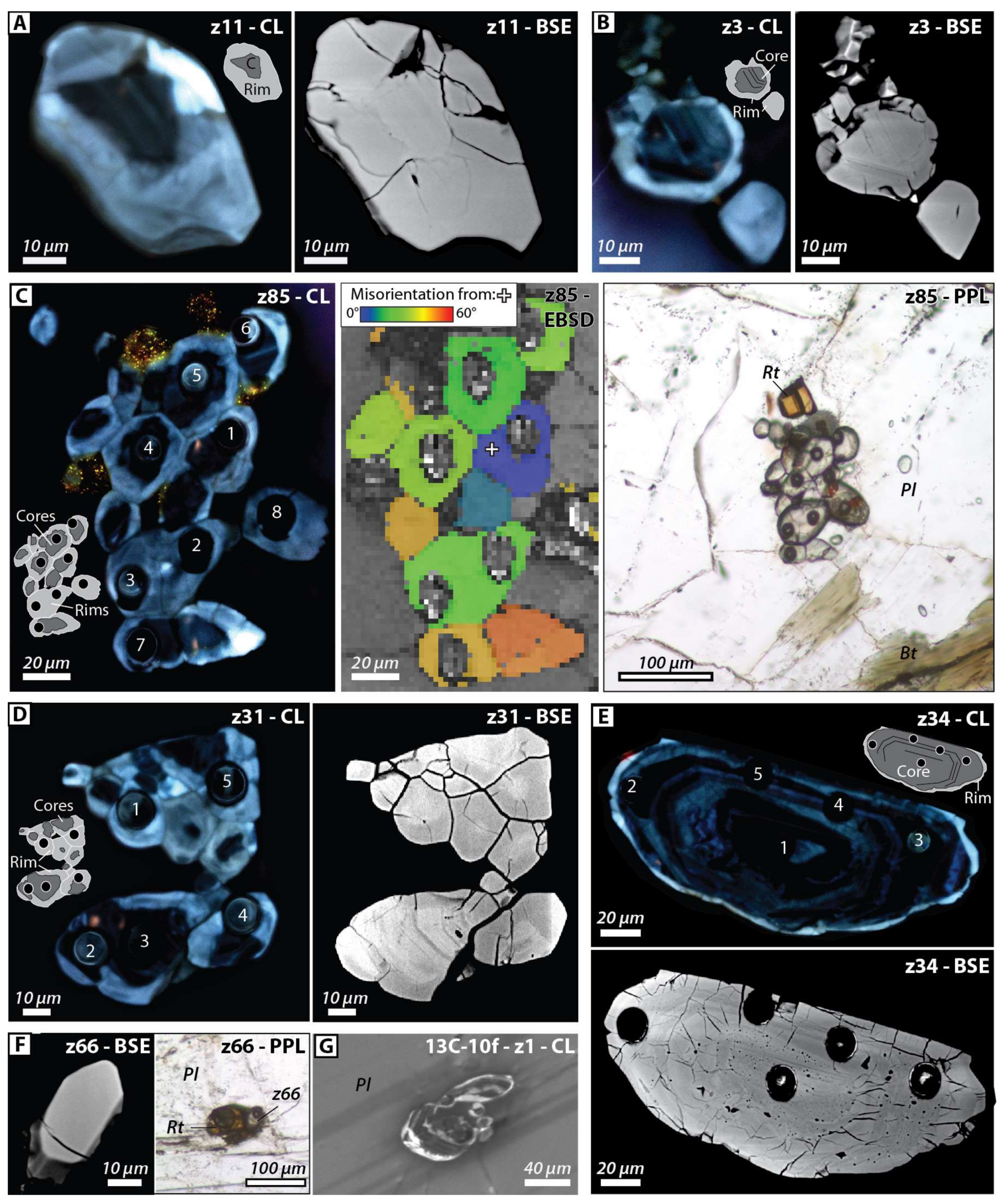

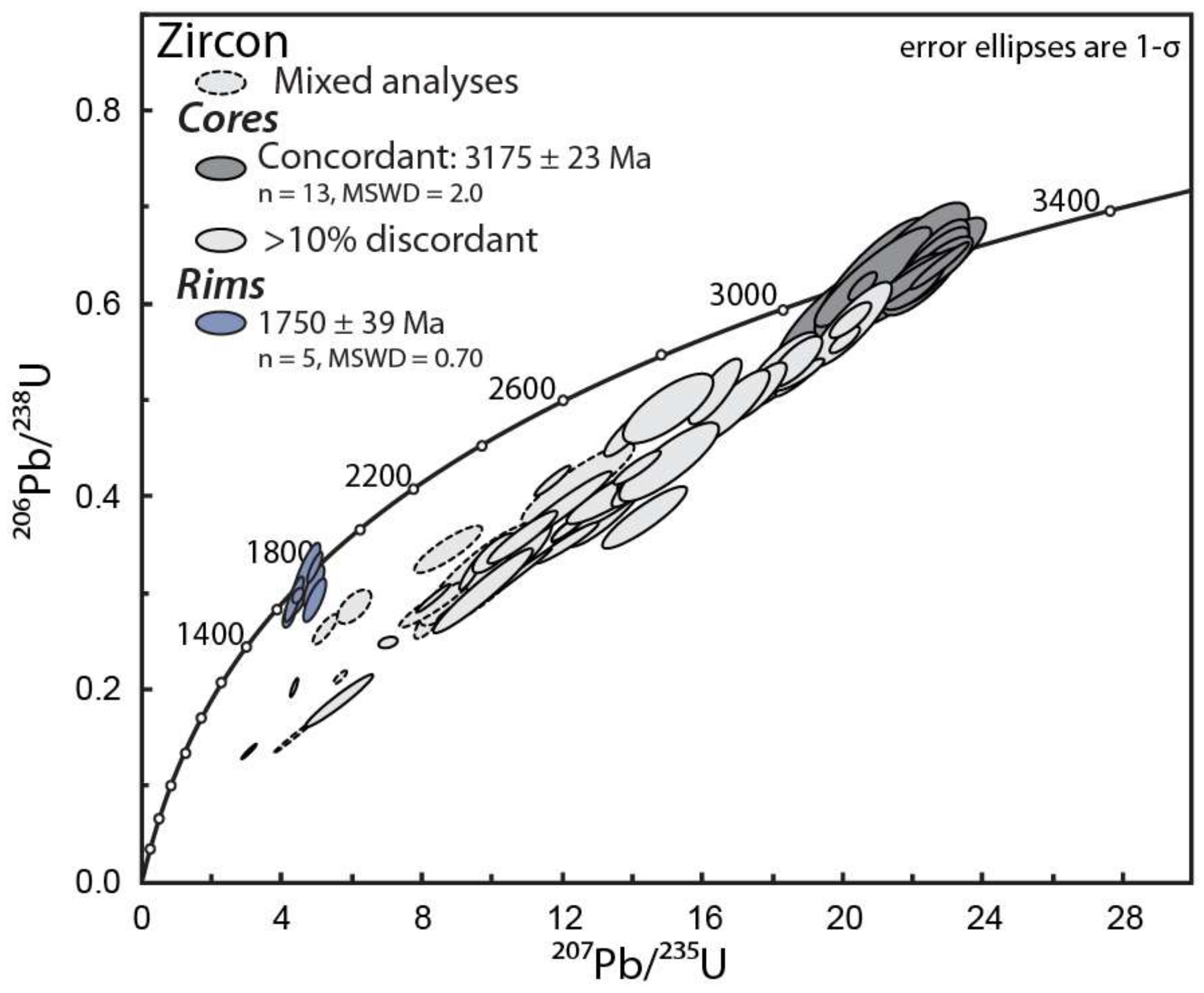
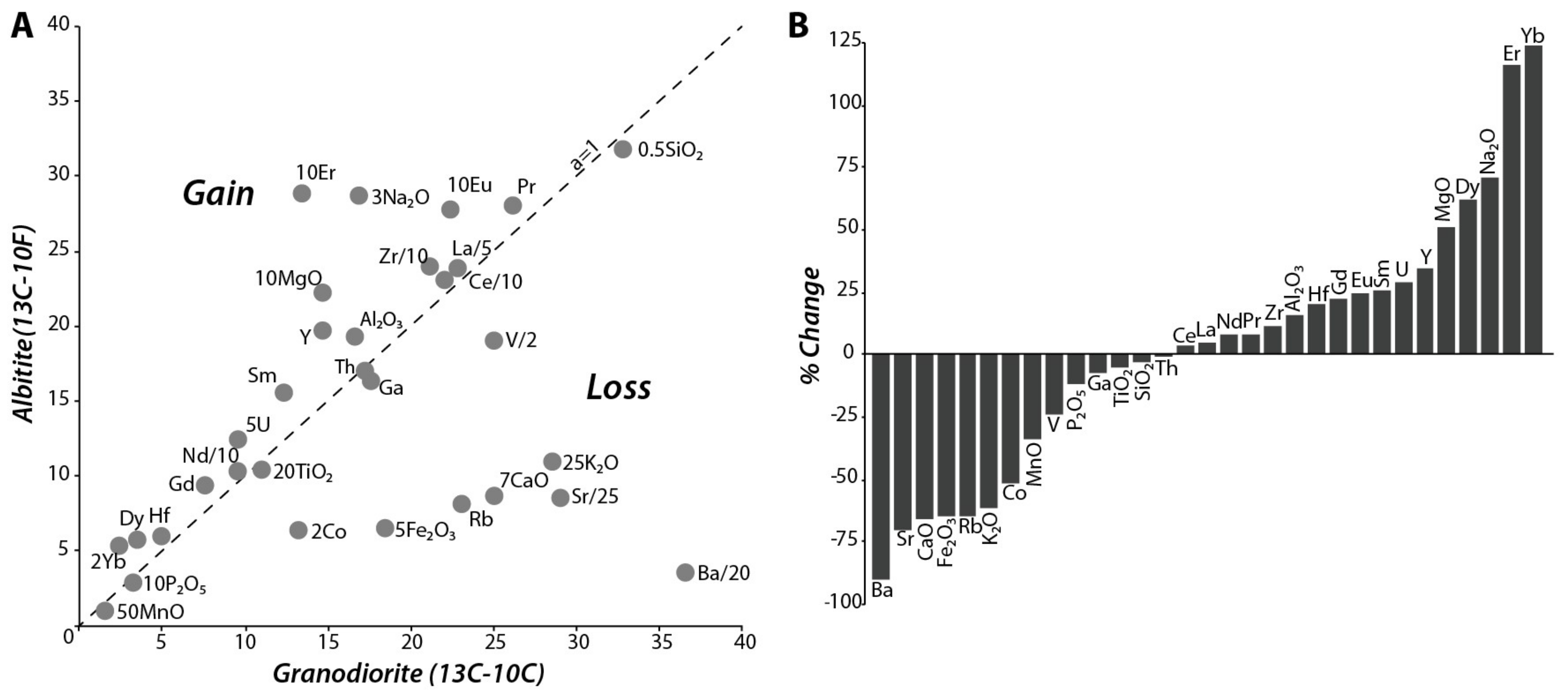
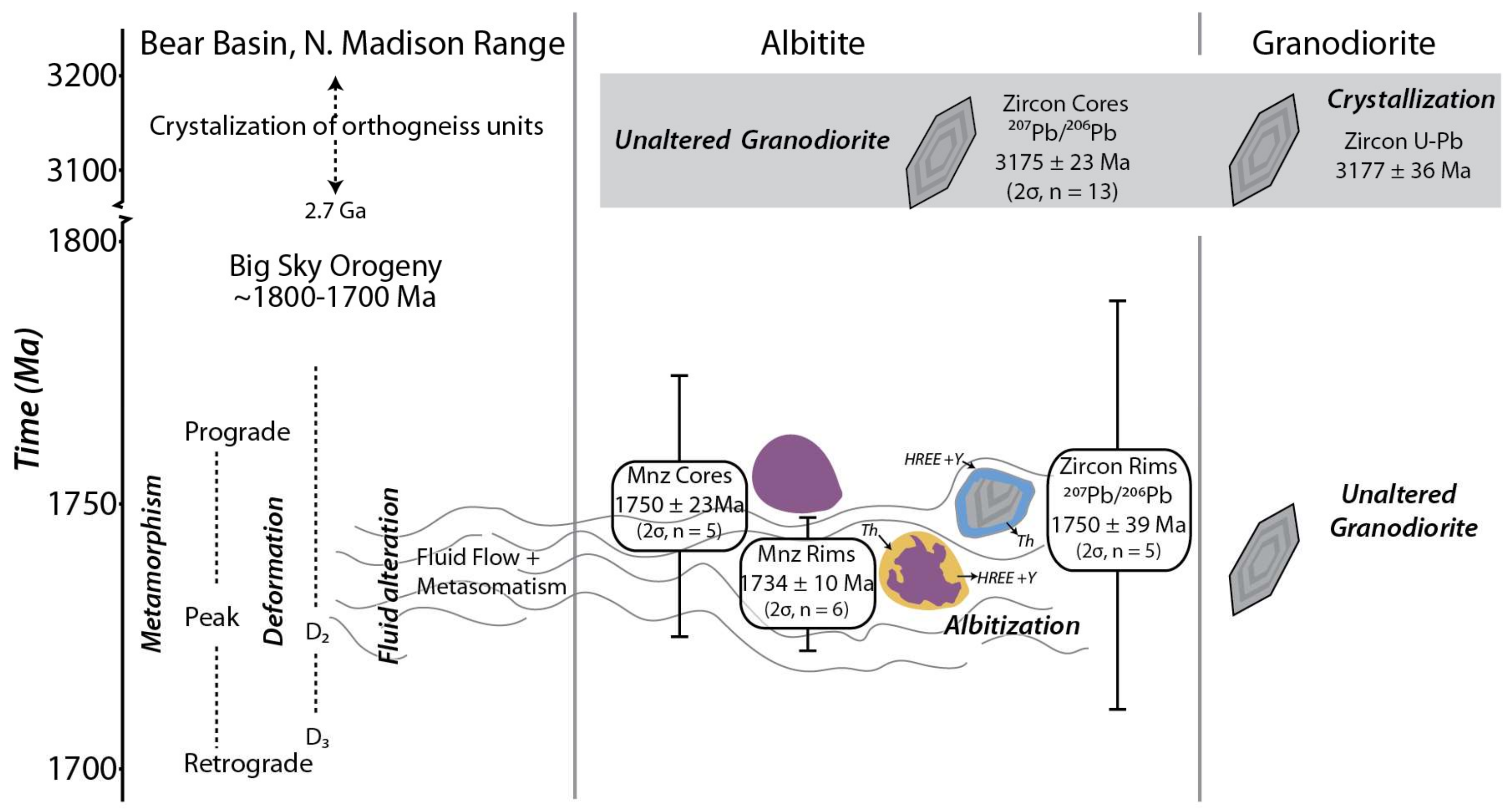
| Feldspar | Orthoamphibole | ||||||||||||
|---|---|---|---|---|---|---|---|---|---|---|---|---|---|
| Point | 1 | 2 | 3 | 1 of 7 | 2 of 7 | 3 of 7 | 4 of 7 | 5 of 7 | 6 of 7 | 7 of 7 | 1-Ath | 2-Ath | 4-Ath |
| SiO2 | 64.75 | 66.27 | 66.34 | 65.98 | 66.25 | 65.88 | 66.50 | 66.56 | 66.52 | 66.59 | 56.51 | 56.04 | 55.43 |
| TiO2 | n.m. | n.m. | n.m. | n.m. | n.m. | n.m. | n.m. | n.m. | n.m. | n.m. | 0.00 | 0.00 | 0.05 |
| Al2O3 | 20.67 | 20.68 | 20.61 | 19.64 | 19.83 | 19.46 | 20.05 | 20.32 | 20.47 | 20.02 | 1.09 | 1.33 | 1.61 |
| FeO | 0.03 | 0.02 | 0.01 | 0.06 | 0.03 | 0.00 | 0.03 | 0.03 | 0.01 | 0.04 | 14.35 | 14.34 | 14.24 |
| MgO | 0.00 | 0.00 | 0.00 | 0.00 | 0.00 | 0.00 | 0.00 | 0.00 | 0.00 | 0.00 | 23.98 | 24.05 | 23.89 |
| MnO | 0.00 | 0.00 | 0.00 | 0.01 | 0.00 | 0.00 | 0.01 | 0.01 | 0.00 | 0.00 | 0.58 | 0.60 | 0.67 |
| CaO | 1.13 | 1.20 | 1.17 | 1.14 | 1.14 | 1.13 | 1.21 | 1.31 | 1.24 | 0.64 | 0.14 | 0.13 | 0.12 |
| Na2O | 10.76 | 10.89 | 11.00 | 10.94 | 10.90 | 10.77 | 10.71 | 10.79 | 10.77 | 11.12 | 0.07 | 0.12 | 0.17 |
| K2O | 0.10 | 0.04 | 0.04 | 0.04 | 0.04 | 0.04 | 0.03 | 0.05 | 0.03 | 0.01 | 0.00 | 0.00 | 0.00 |
| H2O | - | - | - | - | - | - | - | - | - | - | 2.13 | 2.13 | 2.11 |
| Total | 97.45 | 99.09 | 99.17 | 97.81 | 98.18 | 97.29 | 98.55 | 99.07 | 99.05 | 98.43 | 98.86 | 98.74 | 98.30 |
| An | 0.05 | 0.06 | 0.06 | 0.06 | 0.06 | 0.05 | 0.06 | 0.06 | 0.06 | 0.06 | |||
| Ab | 0.94 | 0.94 | 0.94 | 0.94 | 0.94 | 0.94 | 0.94 | 0.93 | 0.94 | 0.94 | |||
| Or | 0.01 | 0.00 | 0.00 | 0.00 | 0.00 | 0.01 | 0.00 | 0.01 | 0.00 | 0.00 | |||
| Si p.f.u.* | 7.95 | 7.90 | 7.86 | ||||||||||
| Mg# | 0.75 | 0.75 | 0.75 | ||||||||||
| Albitites | Porph. | Bt ± Grt | Bear Basin | Leucogranites | |||||||
|---|---|---|---|---|---|---|---|---|---|---|---|
| Grano. | Gneiss | Schist | |||||||||
| Major Elements (wt %) | |||||||||||
| Sample | 13c-10a | 13c-10d | 13c-10e | 13c-10f | 13c-10c | 15c-21a | 8KRB-7c | 11C-06a | KM13-27 | ||
| SiO2 | 63.2 | 63.09 | 66.80 | 63.65 | 65.45 | 57.62 | 73.69 | 71.81 | 77.07 | ||
| TiO2 | 0.54 | 0.48 | 0.51 | 0.52 | 0.55 | 0.26 | 0.31 | 0.1 | bdl | ||
| Al2O3 | 19.29 | 18.91 | 18.66 | 19.36 | 16.66 | 12.08 | 13.41 | 16.63 | 13.69 | ||
| Fe2O3 | 1.38 | 1.61 | 0.69 | 1.30 | 3.70 | 23.50 | 3.9 | 1.32 | 1.15 | ||
| MgO | 2.33 | 3.31 | 1.24 | 2.22 | 1.47 | 3.98 | 2.62 | 0.55 | 0.07 | ||
| MnO | 0.02 | 0.02 | 0.00 | 0.02 | 0.03 | 0.18 | 0.07 | 0.02 | 0.06 | ||
| CaO | 1.39 | 1.05 | 1.16 | 1.24 | 3.57 | 0.37 | 0.54 | 1.45 | 1.06 | ||
| Na2O | 9.23 | 9.24 | 9.37 | 9.56 | 5.61 | 1.19 | 3.11 | 4.02 | 6 | ||
| K2O | 0.57 | 0.79 | 0.42 | 0.44 | 1.14 | 0.69 | 1.49 | 2.65 | 0.71 | ||
| LOI | 1.5 | 1.1 | 0.7 | 1.2 | 1.2 | -0.1 | 0.5 | 1.2 | 0.1 | ||
| Total | 99.81 | 99.86 | 99.89 | 99.84 | 99.72 | 99.86 | 99.79 | 99.82 | 99.94 | ||
| Trace elements (ppm) | |||||||||||
| Ba | 109 | 106 | 77 | 72 | 732 | 341 | 870 | 839 | 7 | ||
| Be | 3 | bdl | 3 | 2 | bdl | 3 | 1 | bdl | 2 | ||
| Co | 3.8 | 4.8 | 1.4 | 3.2 | 6.6 | 14.9 | 12.6 | 2 | 0.5 | ||
| Cs | 1 | 1.5 | 0.5 | 0.7 | 0.5 | 0.8 | 0.7 | 0.8 | 0.3 | ||
| Ga | 16.8 | 17.3 | 14.8 | 16.4 | 17.6 | 13.8 | 15.7 | 18.7 | 20.7 | ||
| Hf | 5.2 | 5.2 | 5.9 | 6.0 | 5.0 | 2.0 | 3.8 | 1.4 | 1.1 | ||
| Nb | 10.3 | 7.7 | 9.4 | 9.7 | 9.1 | 6.3 | 6.1 | 2.4 | 5.1 | ||
| Rb | 11 | 17.8 | 7.3 | 8.2 | 23.1 | 19.1 | 40.5 | 57.5 | 21.6 | ||
| Sn | 2 | 2 | 1 | 2 | 2 | bdl | 1 | bdl | bdl | ||
| Sr | 254.5 | 181.4 | 222.3 | 212.3 | 726.2 | 33.3 | 118.4 | 230.9 | 16 | ||
| Ta | 0.9 | 0.7 | 0.9 | 1.0 | 0.6 | 0.6 | 0.5 | bdl | 0.3 | ||
| Th | 18.1 | 11.2 | 14.8 | 17.0 | 17.2 | 9.5 | 16.4 | 1.2 | 7.3 | ||
| U | 2.8 | 1.3 | 2.0 | 3.1 | 2.4 | 5.7 | 4.5 | 0.5 | 2.7 | ||
| V | 53 | 56 | 22 | 38 | 50 | 71 | 42 | 16 | 11 | ||
| W | 8.4 | 4.6 | 1.5 | 7.1 | bdl | bdl | bdl | bdl | bdl | ||
| Zr | 209 | 202.6 | 238.5 | 237.8 | 214.0 | 77.5 | 125.4 | 45.4 | 18.5 | ||
| Y | 31.6 | 16.9 | 18.1 | 19.7 | 14.7 | 16.5 | 13.2 | 5.1 | 19.6 | ||
| La | 124.5 | 59.7 | 58.4 | 119.2 | 114.2 | 21.1 | 35.8 | 8.6 | 5 | ||
| Ce | 243.2 | 109.7 | 114.8 | 230.1 | 221.3 | 33.5 | 63.5 | 15.1 | 9.4 | ||
| Pr | 26.68 | 12.82 | 13.50 | 28.08 | 25.93 | 3.87 | 6.35 | 1.62 | 1.03 | ||
| Nd | 91.8 | 46.6 | 48.5 | 103.6 | 95.8 | 13.6 | 20.9 | 6 | 3.2 | ||
| Sm | 14.37 | 7.21 | 7.17 | 15.49 | 12.34 | 2.41 | 3.26 | 0.89 | 1.14 | ||
| Eu | 2.78 | 1.64 | 1.44 | 2.69 | 2.24 | 0.62 | 0.65 | 0.27 | 0.04 | ||
| Gd | 9.31 | 5.12 | 5.04 | 9.56 | 7.61 | 2.54 | 2.75 | 0.86 | 1.45 | ||
| Tb | 1.12 | 0.60 | 0.65 | 0.95 | 0.78 | 0.46 | 0.40 | 0.14 | 0.36 | ||
| Dy | 5.68 | 3.15 | 3.42 | 4.28 | 3.51 | 2.67 | 2.23 | 0.86 | 2.62 | ||
| Ho | 0.96 | 0.58 | 0.62 | 0.64 | 0.49 | 0.50 | 0.45 | 0.16 | 0.57 | ||
| Er | 2.89 | 1.89 | 1.67 | 1.62 | 1.34 | 1.38 | 1.37 | 0.49 | 2.08 | ||
| Tm | 0.41 | 0.27 | 0.23 | 0.26 | 0.19 | 0.22 | 0.21 | 0.08 | 0.39 | ||
| Yb | 2.64 | 1.91 | 1.53 | 1.56 | 1.18 | 1.31 | 1.43 | 0.47 | 3.02 | ||
| Lu | 0.37 | 0.27 | 0.21 | 0.21 | 0.14 | 0.21 | 0.23 | 0.07 | 0.45 | ||
| Grain | Date | Text. Setting | Domain | Trace Element Concentrations (ppm) | N(n)† | Date | 2σ | |||||||
|---|---|---|---|---|---|---|---|---|---|---|---|---|---|---|
| Analyzed * | Y | 2σ | U | 2σ | Th | 2σ | Pb | 2σ | (Ma) | (Ma) | ||||
| Cores | ||||||||||||||
| m3 | 12/22/14 | g.b. Bt/Pl | Core | 12612 | 1344 | 1930 | 402 | 54727 | 17792 | 5086 | 1606 | 5(5) | 1773 | 58 |
| m12 | 12/22/13 | g.b. Pl/Zrn/Rt | Core | 11733 | 1898 | 2094 | 134 | 17645 | 3380 | 2037 | 174 | 5(5) | 1735 | 106 |
| m93a | 12/22/14 | Ap | Core | 10163 | 1398 | 2000 | 492 | 2862 | 1250 | 822 | 220 | 5(5) | 1743 | 31 |
| m113 | 12/22/14 | Pl | Core | 8585 | 1004 | 1397 | 736 | 4113 | 3822 | 719 | 482 | 5(5) | 1685 | 90 |
| m124 | 12/22/14 | Oam | Core | 12642 | 688 | 1513 | 142 | 8997 | 990 | 1210 | 148 | 5(5) | 1792 | 66 |
| Wt. Mean: | 1750 | 23 | ||||||||||||
| MSWD: | 1.15 | |||||||||||||
| Rims/Whole | ||||||||||||||
| m3 | 12/22/14 | g.b. Bt/Pl | Rim | 7921 | 890 | 2660 | 182 | 25424 | 1694 | 2858 | 138 | 5(5) | 1754 | 36 |
| m7 | 12/26/14 | Bt | Whole | 8404 | 590 | 3134 | 474 | 19846 | 1206 | 2553 | 138 | 6(6) | 1758 | 24 |
| m33 | 12/26/14 | Pl | Rim | 6788 | 658 | 2599 | 190 | 18976 | 1544 | 2280 | 146 | 5(5) | 1729 | 44 |
| m93a | 12/22/14 | Ap | Rim | 7430 | 718 | 2550 | 630 | 15963 | 1682 | 2041 | 232 | 5(5) | 1741 | 56 |
| m96 | 12/26/14 | g.b. Rt/Pl | Whole | 8571 | 266 | 2801 | 140 | 18192 | 1142 | 2273 | 100 | 6(6) | 1727 | 20 |
| m113 | 12/22/14 | Pl | Rim | 6301 | 842 | 2505 | 648 | 18859 | 3608 | 2242 | 420 | 3(5) | 1728 | 18 |
| m116 | 12/23/14 | g.b. Ap/Pl | Whole | 7679 | 1124 | 2820 | 590 | 20858 | 1712 | 2486 | 230 | 6(6) | 1723 | 26 |
| m124 | 12/22/14 | Oam | Rim | 7363 | 1264 | 2770 | 242 | 19977 | 1538 | 2405 | 204 | 6(6) | 1725 | 38 |
| Wt. Mean: | 1734 | 10 | ||||||||||||
| MSWD: | 1.03 | |||||||||||||
| Consistency Standard | ||||||||||||||
| 12/22/14 | 11090 | 142 | 933 | 58 | 60831 | 222 | 1455 | 56 | 4(4) | 507 | 19 | |||
| 12/22/14 | 11030 | 106 | 1189 | 144 | 61157 | 460 | 1482 | 64 | 6(6) | 507 | 22 | |||
| 12/23/14 | 11343 | 174 | 967 | 80 | 60935 | 216 | 1443 | 36 | 6(6) | 501 | 12 | |||
| 12/23/14 | 11412 | 176 | 932 | 94 | 60912 | 236 | 1449 | 32 | 6(6) | 504 | 16 | |||
| 12/26/14 | 11336 | 236 | 993 | 100 | 61050 | 276 | 1456 | 18 | 6(6) | 504 | 6 | |||
| 12/26/14 | 11176 | 144 | 932 | 122 | 60794 | 376 | 1434 | 32 | 6(6) | 500 | 10 | |||
| Wt. Mean: | 503 | 4 | ||||||||||||
| MSWD: | 0.18 | |||||||||||||
| Element (ppm) | Monazite Cores | |||||||||||
| m3 core | m93a core | m113 core | m124 core | |||||||||
| La | 119,068 | 141,130 | 149,867 | 113,933 | ||||||||
| Ce | 238,550 | 275,997 | 280,911 | 254,699 | ||||||||
| Pr | 25,832 | 28,662 | 27,915 | 31,054 | ||||||||
| Nd | 96,513 | 105,262 | 98,427 | 130,413 | ||||||||
| Sm | 7904 | 7036 | 5095 | 10,652 | ||||||||
| Eu | 1656 | 1559 | 1508 | 1323 | ||||||||
| Gd | 8852 | 8129 | 6737 | 10,762 | ||||||||
| Tb | 468 | 436 | - | - | ||||||||
| Dy | 3146 | 2381 | 2026 | 3231 | ||||||||
| Y | 12,684 | 10,150 | 8573 | 12,656 | ||||||||
| Ho | - | - | - | - | ||||||||
| Er | 777 | 759 | 710 | 948 | ||||||||
| Tm | 834 | 904 | 576 | 895 | ||||||||
| Yb | - | - | - | - | ||||||||
| Element (ppm) | Monazite Rims | |||||||||||
| m3 rim | m93a rim | m113 rim | m124 rim | m12 | m116 | m7 | m96 | m33 | ||||
| La | 136,363 | 144,043 | 143,050 | 139,348 | 138,438 | 139,458 | 136,420 | 136,288 | 140,532 | |||
| Ce | 263,718 | 274,811 | 272,628 | 269,086 | 266,595 | 270,552 | 266,161 | 269,439 | 272,556 | |||
| Pr | 27,414 | 27,187 | 27,415 | 27,286 | 27,149 | 27,499 | 27,674 | 27,737 | 27,580 | |||
| Nd | 97,694 | 96,188 | 97,102 | 98,831 | 99,080 | 100,171 | 101,508 | 102,750 | 100,543 | |||
| Sm | 5615 | 5154 | 4346 | 5103 | 6898 | 5282 | 6026 | 5966 | 5402 | |||
| Eu | 933 | 1408 | 1117 | 999 | 1699 | 1066 | 1120 | 1418 | 1094 | |||
| Gd | 6650 | 5943 | 5206 | 5530 | 7236 | 6098 | 6724 | 6970 | 6208 | |||
| Tb | - | - | - | - | 332 | - | - | 247 | 311 | |||
| Dy | 1799 | 1602 | 1098 | 1504 | 2705 | 1786 | 1875 | 1736 | 1590 | |||
| Y | 7943 | 7444 | 6315 | 7380 | 11,659 | 7697 | 8423 | 8589 | 6803 | |||
| Ho | - | - | - | - | - | - | - | - | - | |||
| Er | 498 | 432 | 656 | 389 | 919 | 593 | 549 | 602 | 548 | |||
| Tm | 941 | 853 | 429 | 464 | 768 | 738 | 767 | 704 | 874 | |||
| Yb | - | - | - | - | 408 | - | - | - | - | |||
| Long Axis | Sidhort Axis | Dates (Ma) | % | |||||||||||||||||||
|---|---|---|---|---|---|---|---|---|---|---|---|---|---|---|---|---|---|---|---|---|---|---|
| Grain | (μm) | (μm) | Spot | Domain | 207Pb/235U | 2σ | 206Pb/238 U | 2σ | 207Pb/206Pb | 2σ | Th (ppm) | U (ppm) | Th/U | 206Pb/238U | 2σ | 207Pb/235U | 2σ | 207Pb/206Pb | 2σ | disco. | ||
| z17 | 110 | 70 | 1 | Core | 22.5 | 1.4 | 0.645 | 0.057 | 0.254 | 0.015 | 57 | 194 | 0.29 | 3210 | 230 | 3212 | 60 | 3181 | 90 | -2.6 | ||
| z8 | 40 | 30 | 2 | Core | 21.8 | 2.3 | 0.642 | 0.084 | 0.249 | 0.021 | 67 | 196 | 0.34 | 3120 | 320 | 3120 | 110 | 3140 | 130 | -2 | ||
| z21 | 60 | 45 | 3 | Core | 20.8 | 2.2 | 0.63 | 0.068 | 0.235 | 0.012 | 182 | 323 | 0.56 | 3120 | 270 | 3122 | 96 | 3088 | 83 | -1.6 | ||
| s* z17 | 40 | 25 | 1 | Core | 22.9 | 1.5 | 0.656 | 0.047 | 0.25 | 0.011 | 132 | 296 | 0.45 | 3240 | 180 | 3213 | 62 | 3191 | 72 | -1.5 | ||
| z8 | 40 | 30 | 1 | Core | 20.8 | 2.2 | 0.627 | 0.084 | 0.246 | 0.02 | 66 | 161 | 0.41 | 3080 | 330 | 3090 | 110 | 3120 | 120 | -1 | ||
| z17 | 110 | 70 | 4 | Core | 22.4 | 1.5 | 0.639 | 0.056 | 0.255 | 0.013 | 62 | 209 | 0.30 | 3180 | 220 | 3191 | 71 | 3192 | 78 | -0.9 | ||
| s z21 | 100 | 55 | 1 | Core | 20.52 | 0.55 | 0.62 | 0.02 | 0.239 | 0.0055 | 97 | 223 | 0.43 | 3108 | 78 | 3115 | 26 | 3111 | 37 | -0.2 | ||
| z88 | 60 | 50 | 1 | Core | 22.7 | 1.3 | 0.642 | 0.039 | 0.2515 | 0.0087 | 84 | 271 | 0.31 | 3180 | 150 | 3204 | 54 | 3186 | 54 | -0.1 | ||
| s z26 | 120 | 100 | 1 | Core | 22.7 | 1.1 | 0.641 | 0.031 | 0.2524 | 0.0042 | 110 | 340 | 0.32 | 3180 | 130 | 3206 | 52 | 3198 | 26 | 0.3 | ||
| z21 | 60 | 45 | 2 | Core | 22 | 1.2 | 0.625 | 0.038 | 0.248 | 0.011 | 229 | 450 | 0.51 | 3110 | 150 | 3170 | 53 | 3171 | 64 | 0.9 | ||
| s z16 | 100 | 50 | 1 | Core | 22.2 | 1.5 | 0.628 | 0.051 | 0.257 | 0.014 | 147 | 281 | 0.52 | 3130 | 200 | 3184 | 64 | 3215 | 85 | 2 | ||
| z20 | 70 | 45 | 3 | Core | 21.7 | 2 | 0.622 | 0.049 | 0.2525 | 0.0056 | 65 | 131 | 0.50 | 3110 | 200 | 3188 | 79 | 3199 | 37 | 2.3 | ||
| s z18 | 100 | 60 | 1 | Core | 20.17 | 0.75 | 0.584 | 0.024 | 0.2492 | 0.0071 | 111 | 283 | 0.39 | 2958 | 99 | 3093 | 35 | 3172 | 45 | 5.7 | ||
| z9 | 45 | 40 | 2 | Core | 19.4 | 1.8 | 0.582 | 0.068 | 0.252 | 0.016 | 236 | 438 | 0.54 | 2900 | 280 | 3052 | 96 | 3180 | 100 | 7 | ||
| z53 | 45 | 45 | 2 | Core | 20.2 | 1.5 | 0.582 | 0.058 | 0.258 | 0.015 | 138 | 324 | 0.43 | 2910 | 230 | 3076 | 71 | 3220 | 94 | 7.5 | ||
| s z17 | 40 | 25 | 2 | Core | 20.01 | 0.54 | 0.564 | 0.017 | 0.2529 | 0.0056 | 225 | 377 | 0.60 | 2880 | 71 | 3090 | 26 | 3200 | 35 | 10 | ||
| z17 | 110 | 70 | 2 | Core | 15 | 1.7 | 0.493 | 0.048 | 0.218 | 0.015 | 88 | 324 | 0.27 | 2550 | 210 | 2820 | 110 | 2970 | 130 | 10.7 | ||
| z16 | 40 | 30 | 2 | Core | 18.2 | 1.4 | 0.533 | 0.051 | 0.246 | 0.013 | 347 | 507 | 0.68 | 2730 | 210 | 3007 | 73 | 3143 | 82 | 10.8 | ||
| z21 | 60 | 45 | 1 | Core | 16.3 | 1 | 0.51 | 0.045 | 0.23 | 0.012 | 280 | 513 | 0.55 | 2630 | 190 | 2901 | 62 | 3042 | 85 | 11.1 | ||
| z54 | 80 | 70 | 2 | Core | 18.6 | 1 | 0.542 | 0.035 | 0.2482 | 0.0091 | 88 | 286 | 0.31 | 2780 | 150 | 3029 | 49 | 3162 | 58 | 13 | ||
| s z1 | 100 | 50 | 1b | Core | 18.73 | 0.94 | 0.528 | 0.022 | 0.2543 | 0.0065 | 233 | 364 | 0.64 | 2728 | 91 | 3021 | 50 | 3208 | 41 | 15.4 | ||
| z59 | 40 | 30 | 4 | Core | 17.5 | 1.1 | 0.511 | 0.039 | 0.249 | 0.013 | 270 | 476 | 0.57 | 2640 | 170 | 2947 | 61 | 3157 | 77 | 16 | ||
| z34 | 200 | 80 | 5 | Core | 18.72 | 0.88 | 0.525 | 0.026 | 0.2577 | 0.0049 | 20 | 254 | 0.08 | 2720 | 110 | 3024 | 44 | 3231 | 30 | 16.1 | ||
| z54 | 80 | 70 | 1 | Core | 13.83 | 0.91 | 0.469 | 0.034 | 0.2203 | 0.0077 | 94 | 310 | 0.30 | 2460 | 150 | 2729 | 62 | 2972 | 56 | 16.2 | ||
| z54 | 80 | 70 | 3 | Core | 16.8 | 1.4 | 0.495 | 0.05 | 0.246 | 0.014 | 91 | 367 | 0.25 | 2560 | 210 | 2896 | 88 | 3147 | 89 | 16.5 | ||
| z89L | 50 | 30 | 1 | Core | 16.35 | 0.79 | 0.478 | 0.02 | 0.2464 | 0.0051 | 750 | 890 | 0.84 | 2514 | 89 | 2904 | 48 | 3158 | 33 | 19.6 | ||
| z2 | 70 | 60 | 4 | Core | 11.69 | 0.67 | 0.418 | 0.021 | 0.2014 | 0.0046 | 82 | 386 | 0.21 | 2246 | 94 | 2566 | 55 | 2833 | 37 | 20.7 | ||
| z85 | 150 | 50 | 6 | Core | 14.1 | 0.87 | 0.432 | 0.023 | 0.225 | 0.0064 | 147 | 401 | 0.37 | 2310 | 110 | 2766 | 51 | 3014 | 45 | 20.9 | ||
| z9 | 45 | 40 | 1 | Core | 15 | 1.9 | 0.438 | 0.054 | 0.242 | 0.017 | 177 | 365 | 0.48 | 2350 | 250 | 2790 | 120 | 3110 | 110 | 23.3 | ||
| z85 | 150 | 50 | 2 | Core | 13.94 | 0.54 | 0.424 | 0.023 | 0.2423 | 0.0077 | 54 | 166 | 0.32 | 2280 | 100 | 2752 | 41 | 3131 | 50 | 26.7 | ||
| z59 | 40 | 30 | 3 | Core | 14.4 | 1.4 | 0.426 | 0.046 | 0.24 | 0.011 | 289 | 530 | 0.55 | 2300 | 210 | 2761 | 87 | 3120 | 74 | 27.1 | ||
| z20 | 70 | 45 | 1 | Core | 13.5 | 1.9 | 0.406 | 0.042 | 0.2209 | 0.0082 | 323 | 1086 | 0.30 | 2190 | 190 | 2690 | 130 | 2983 | 60 | 27.3 | ||
| s z24 | 60 | 60 | 1 | Core | 13.4 | 1.7 | 0.401 | 0.045 | 0.235 | 0.012 | 32 | 416 | 0.08 | 2200 | 220 | 2700 | 120 | 3088 | 74 | 27.7 | ||
| z85 | 150 | 50 | 5 | Core | 11.9 | 1.9 | 0.389 | 0.052 | 0.214 | 0.01 | 82 | 393 | 0.21 | 2070 | 240 | 2520 | 170 | 2929 | 78 | 30 | ||
| z59 | 40 | 30 | 1 | Core | 13.2 | 1.4 | 0.385 | 0.045 | 0.237 | 0.013 | 280 | 624 | 0.45 | 2160 | 230 | 2660 | 100 | 3114 | 95 | 30.9 | ||
| z85 | 150 | 50 | 4 | Core | 10.8 | 1.3 | 0.36 | 0.035 | 0.2069 | 0.0069 | 92 | 385 | 0.24 | 1990 | 170 | 2470 | 110 | 2903 | 56 | 33.4 | ||
| z31 | 60 | 60 | 3 | Core | 10.01 | 0.83 | 0.343 | 0.027 | 0.211 | 0.011 | 183 | 429 | 0.43 | 1890 | 130 | 2419 | 76 | 2905 | 81 | 34.1 | ||
| s z1 | 100 | 50 | 2 | Rim | 12.18 | 0.72 | 0.371 | 0.021 | 0.2356 | 0.0049 | 225 | 517 | 0.44 | 2025 | 99 | 2602 | 55 | 3086 | 33 | 34.6 | ||
| z19 | 70 | 45 | 1 | Core | 12.18 | 0.68 | 0.369 | 0.02 | 0.2364 | 0.0073 | 79 | 324 | 0.24 | 2039 | 92 | 2619 | 50 | 3107 | 48 | 34.6 | ||
| z16 | 40 | 30 | 1 | Core | 14.3 | 1.6 | 0.38 | 0.043 | 0.256 | 0.014 | 535 | 569 | 0.94 | 2050 | 200 | 2720 | 110 | 3243 | 85 | 35.8 | ||
| z53 | 45 | 45 | 1 | Core | 10.96 | 0.88 | 0.349 | 0.034 | 0.236 | 0.014 | 257 | 494 | 0.52 | 1910 | 160 | 2491 | 76 | 3058 | 97 | 36.1 | ||
| s z1 | 100 | 50 | 3 | Core | 12.52 | 0.46 | 0.367 | 0.016 | 0.251 | 0.0058 | 210 | 379 | 0.55 | 2012 | 77 | 2646 | 37 | 3187 | 37 | 37.4 | ||
| z19 | 70 | 45 | 2 | Core | 12.1 | 1.2 | 0.354 | 0.029 | 0.2352 | 0.0057 | 461 | 610 | 0.76 | 1940 | 140 | 2574 | 90 | 3083 | 39 | 37.5 | ||
| z34 | 200 | 80 | 2 | Core | 9.39 | 0.46 | 0.324 | 0.024 | 0.2154 | 0.0057 | 124 | 770 | 0.16 | 1800 | 120 | 2383 | 48 | 2943 | 42 | 38.6 | ||
| z2 | 70 | 60 | 1 | Core | 8.28 | 0.63 | 0.297 | 0.019 | 0.2029 | 0.0045 | 149 | 884 | 0.17 | 1706 | 99 | 2262 | 73 | 2845 | 37 | 40 | ||
| s z26 | 120 | 100 | 2 | Core | 9.12 | 0.95 | 0.289 | 0.022 | 0.2213 | 0.0072 | 136 | 543 | 0.25 | 1630 | 110 | 2348 | 92 | 2980 | 59 | 42.8 | ||
| z34 | 200 | 80 | 4 | Core | 10.3 | 1.8 | 0.311 | 0.049 | 0.2333 | 0.0061 | 191 | 820 | 0.23 | 1700 | 230 | 2330 | 160 | 3068 | 42 | 45.3 | ||
| z34 | 200 | 80 | 3 | Core | 9.7 | 1.9 | 0.304 | 0.057 | 0.2134 | 0.0099 | 242 | 1300 | 0.19 | 1650 | 280 | 2170 | 230 | 2911 | 77 | 46.8 | ||
| z20 | 70 | 45 | 2 | Core | 7 | 0.36 | 0.251 | 0.0086 | 0.195 | 0.011 | 458 | 2580 | 0.18 | 1443 | 45 | 2107 | 47 | 2800 | 100 | 47.1 | ||
| z2 | 70 | 60 | 3 | Core | 4.31 | 0.17 | 0.205 | 0.013 | 0.1546 | 0.0062 | 163 | 880 | 0.19 | 1197 | 69 | 1690 | 32 | 2383 | 68 | 50.6 | ||
| z34 | 200 | 80 | 1 | Core | 5.6 | 1.3 | 0.19 | 0.036 | 0.1957 | 0.0093 | 600 | 1980 | 0.30 | 1130 | 190 | 1760 | 180 | 2770 | 77 | 60.5 | ||
| z2 | 70 | 60 | 2 | Core | 3.04 | 0.28 | 0.138 | 0.011 | 0.1591 | 0.0042 | 144 | 1405 | 0.10 | 829 | 60 | 1401 | 74 | 2438 | 45 | 65.8 | ||
| z85 | 150 | 50 | 3 | Rim | 4.92 | 0.28 | 0.329 | 0.02 | 0.1064 | 0.0041 | 3 | 153 | 0.02 | 1827 | 98 | 1812 | 49 | 1735 | 68 | -6.9 | ||
| z31 | 60 | 60 | 4 | Rim | 4.62 | 0.56 | 0.317 | 0.049 | 0.111 | 0.01 | 2 | 82 | 0.03 | 1750 | 240 | 1750 | 110 | 1770 | 160 | -5 | ||
| z66 | 30 | 20 | 1 | Whole | 4.32 | 0.37 | 0.295 | 0.031 | 0.1097 | 0.0072 | 0 | 125 | 0.00 | 1650 | 150 | 1675 | 68 | 1770 | 120 | 0 | ||
| z76 | 60 | 20 | 1 | Rim | 4.42 | 0.19 | 0.299 | 0.01 | 0.1059 | 0.0039 | 2 | 119 | 0.02 | 1683 | 50 | 1712 | 36 | 1722 | 69 | 2.8 | ||
| z31 | 60 | 60 | 1 | Rim | 4.87 | 0.42 | 0.309 | 0.029 | 0.1119 | 0.006 | 7 | 136 | 0.05 | 1730 | 140 | 1781 | 74 | 1813 | 95 | 4 | ||
| s z1 | 100 | 50 | 1a | Rim | 4.17 | 0.22 | 0.28 | 0.019 | 0.107 | 0.0061 | 1 | 161 | 0.01 | 1587 | 96 | 1664 | 44 | 1740 | 100 | 10 | ||
| z31 | 60 | 60 | 5 | Rim | 4.91 | 0.44 | 0.295 | 0.029 | 0.1222 | 0.0071 | 25 | 144 | 0.18 | 1650 | 140 | 1790 | 77 | 1958 | 99 | 16.1 | ||
| z59 | 40 | 30 | 2 | Mix | 12.4 | 2.1 | 0.415 | 0.056 | 0.2 | 0.019 | 54 | 272 | 0.20 | 2200 | 250 | 2510 | 180 | 2810 | 160 | 20.1 | ||
| z31 | 60 | 60 | 2 | Mix | 8.7 | 1.3 | 0.347 | 0.033 | 0.175 | 0.015 | 72 | 248 | 0.29 | 1900 | 160 | 2230 | 140 | 2550 | 160 | 22.6 | ||
| z85 | 150 | 50 | 7 | Mix | 6.01 | 0.65 | 0.287 | 0.023 | 0.149 | 0.011 | 21 | 270 | 0.08 | 1620 | 110 | 1980 | 100 | 2360 | 140 | 28.8 | ||
| z85 | 150 | 50 | 1 | Mix | 5.18 | 0.48 | 0.265 | 0.02 | 0.1363 | 0.0066 | 24 | 243 | 0.10 | 1510 | 100 | 1879 | 80 | 2193 | 81 | 30.5 | ||
| z7 | 40 | 30 | 1 | Mix | 9.7 | 2.3 | 0.32 | 0.074 | 0.212 | 0.029 | 179 | 659 | 0.27 | 1750 | 350 | 2290 | 240 | 2850 | 200 | 38 | ||
| z85 | 150 | 50 | 8 | Mix | 8.3 | 1.3 | 0.29 | 0.032 | 0.195 | 0.014 | 46 | 193 | 0.24 | 1650 | 170 | 2160 | 150 | 2760 | 120 | 40.2 | ||
| z17 | 110 | 70 | 3 | Mix | 8.58 | 0.9 | 0.29 | 0.029 | 0.212 | 0.015 | 259 | 630 | 0.41 | 1620 | 140 | 2274 | 90 | 2900 | 120 | 42.3 | ||
| z73 | 40 | 25 | 1 | Mix | 8.33 | 0.75 | 0.281 | 0.035 | 0.219 | 0.012 | 580 | 405 | 1.43 | 1590 | 170 | 2252 | 85 | 2959 | 89 | 46.9 | ||
| z89U | 50 | 40 | 1 | Mix | 5.63 | 0.26 | 0.2142 | 0.0086 | 0.1908 | 0.0055 | 162 | 567 | 0.29 | 1250 | 45 | 1913 | 39 | 2741 | 47 | 53.8 | ||
| s z26 | 120 | 100 | 3 | Mix | 4.29 | 0.77 | 0.153 | 0.023 | 0.2034 | 0.0063 | 424 | 910 | 0.47 | 900 | 130 | 1650 | 150 | 2855 | 52 | 69 | ||
| Element | Rim Zircon | Core Concordant Zircon | ||||||||||||||||||||
|---|---|---|---|---|---|---|---|---|---|---|---|---|---|---|---|---|---|---|---|---|---|---|
| (ppm) | z85 3 | z31 4 | z66 1 | z76 1 | z31 1 | s z1 1a | z17 1 | z8 2 | z21 3 | s z17 4 | z8 1 | z17 4 | s z21 1 | z88 1 | s z26 1 | z 21 2 | s z16 1 | z20 3 | s z18 1 | z9 2 | z53 2 | s z17 2 |
| La | - | - | - | - | - | - | - | - | 6 | 3 | 4 | - | - | - | - | - | - | 4 | - | - | - | - |
| Ce | 2 | 2 | 3 | 1 | 5 | 3 | 20 | 26 | 109 | 57 | 52 | 22 | 34 | 24 | 26 | 51 | 40 | 47 | 39 | 63 | 40 | 57 |
| Pr | 1 | 0 | 1 | 0 | 2 | 1 | 0 | 3 | 19 | 12 | 14 | 0 | 1 | 0 | 0 | 1 | 1 | 9 | 2 | 1 | 1 | 5 |
| Nd | 1 | 0 | 2 | 0 | 1 | 1 | 1 | 4 | 26 | 16 | 15 | 1 | 2 | 1 | 2 | 3 | 2 | 11 | 4 | 3 | 2 | 7 |
| Sm | 4 | 2 | 11 | 2 | 6 | 4 | 10 | 17 | 40 | 25 | 43 | 9 | 17 | 3 | 7 | 17 | 15 | 30 | 22 | 18 | 16 | 24 |
| Eu | 6 | 4 | 7 | 5 | 9 | 6 | 8 | 19 | 43 | 27 | 31 | 8 | 12 | 7 | 10 | 17 | 12 | 66 | 18 | 21 | 15 | 26 |
| Gd | 13 | 11 | 13 | 11 | 13 | 11 | 24 | 31 | 63 | 63 | 47 | 24 | 24 | 22 | 32 | 47 | 31 | 62 | 47 | 55 | 45 | 61 |
| Tb | n/a | n/a | n/a | n/a | n/a | n/a | n/a | n/a | n/a | n/a | n/a | n/a | n/a | n/a | n/a | n/a | n/a | n/a | n/a | n/a | n/a | n/a |
| Dy | 61 | 67 | 60 | 83 | 81 | 66 | 69 | 78 | 135 | 130 | 106 | 69 | 83 | 57 | 93 | 111 | 81 | 126 | 111 | 127 | 109 | 135 |
| Y | 154 | 169 | 130 | 212 | 181 | 169 | 130 | 145 | 241 | 252 | 173 | 141 | 171 | 117 | 199 | 201 | 152 | 248 | 211 | 231 | 210 | 252 |
| Ho | n/a | n/a | n/a | n/a | n/a | n/a | n/a | n/a | n/a | n/a | n/a | n/a | n/a | n/a | n/a | n/a | n/a | n/a | n/a | n/a | n/a | n/a |
| Er | 292 | 306 | 248 | 384 | 309 | 299 | 191 | 209 | 304 | 373 | 223 | 221 | 245 | 173 | 294 | 274 | 204 | 331 | 296 | 323 | 295 | 318 |
| Tm | n/a | n/a | n/a | n/a | n/a | n/a | n/a | n/a | n/a | n/a | n/a | n/a | n/a | n/a | n/a | n/a | n/a | n/a | n/a | n/a | n/a | n/a |
| Yb | 1379 | 1354 | 1161 | 1826 | 1491 | 1385 | 683 | 745 | 888 | 1050 | 584 | 745 | 726 | 609 | 950 | 876 | 563 | 894 | 910 | 1012 | 901 | 852 |
| Grain | Long Axis | Short Axis | Textural | Spot | Domain | Ti (ppm) | Ti-in-Zrn Thermometry | |
|---|---|---|---|---|---|---|---|---|
| (μm) | (μm) | Setting | 2σ | T (C°) | ||||
| z17 | 110 | 70 | Pl/Bt g.b | 1 | Core | 4.8 | 1.3 | 680 |
| z8 | 40 | 30 | Pl g.b | 2 | Core | 5.5 | 1.6 | 691 |
| z21 | 60 | 45 | Pl | 3 | Core | 13.2 | 3.8 | 766 |
| s* z17 | 40 | 25 | n/a | 1 | Core | 8.9 | 2.6 | 731 |
| z8 | 40 | 30 | Pl | 1 | Core | 8.8 | 2.5 | 730 |
| z17 | 110 | 70 | Pl/Bt g.b | 4 | Core | 4.3 | 1.1 | 672 |
| s z21 | 100 | 55 | n/a | 1 | Core | 7.3 | 1.4 | 714 |
| z88 | 60 | 50 | Pl | 1 | Core | 4.3 | 1.3 | 672 |
| s z26 | 120 | 100 | n/a | 1 | Core | 4.6 | 1.3 | 677 |
| z21 | 60 | 45 | Pl g.b | 2 | Core | 7.4 | 1.3 | 715 |
| s z16 | 100 | 50 | n/a | 1 | Core | 6.2 | 2.2 | 701 |
| z20 | 70 | 45 | Pl | 3 | Core | 8.1 | 2.5 | 723 |
| s z18 | 100 | 60 | n/a | 1 | Core | 6.9 | 1.2 | 709 |
| z9 | 45 | 40 | Pl | 2 | Core | 7.7 | 1.8 | 719 |
| z53 | 45 | 45 | Pl | 2 | Core | 7.1 | 1.6 | 712 |
| s z17 | 40 | 25 | n/a | 2 | Core | 8.3 | 2.6 | 725 |
| z17 | 110 | 70 | Pl/Bt g.b | 2 | Core | 15 | 3.8 | 778 |
| z16 | 40 | 30 | Pl/Mnz/Rt g.b. | 2 | Core | 1600 | 1300 | n/a |
| z21 | 60 | 45 | Pl g.b | 1 | Core | 17 | 2.2 | 790 |
| z54 | 80 | 70 | Pl g.b | 2 | Core | 28.3 | 3.1 | 841 |
| s z1 | 100 | 50 | n/a | 1b | Core | 8 | 2.5 | 722 |
| z59 | 40 | 30 | Bt w/Mnz | 4 | Core | 18.2 | 2 | 796 |
| z34 | 200 | 80 | Pl/Bt g.b | 5 | Core | 1840 | 490 | n/a |
| z54 | 80 | 70 | Pl g.b | 1 | Core | 14.1 | 1.9 | 772 |
| z54 | 80 | 70 | Pl g.b | 3 | Core | 18.1 | 2.4 | 796 |
| z89L | 50 | 30 | Pl | 1 | Core | 34 | 7.7 | 861 |
| z2 | 70 | 60 | Pl/Bt g.b | 4 | Core | 24.6 | 5.6 | 827 |
| z85 | 150 | 50 | Pl | 6 | Core | 19.3 | 4.4 | 802 |
| z9 | 45 | 40 | Pl | 1 | Core | 10.4 | 2.3 | 744 |
| z85 | 150 | 50 | Pl | 2 | Core | 8.3 | 1.7 | 725 |
| z59 | 40 | 30 | Bt w/Mnz | 3 | Core | 74 | 35 | 954 |
| z20 | 70 | 45 | Pl | 1 | Core | 31.3 | 5.6 | 852 |
| s z24 | 60 | 60 | n/a | 1 | Core | 7.8 | 2.3 | 720 |
| z85 | 150 | 50 | Pl | 5 | Core | 17.2 | 3.7 | 791 |
| z59 | 40 | 30 | Bt w/Mnz | 1 | Core | 20.4 | 2.9 | 808 |
| z85 | 150 | 50 | Pl | 4 | Core | 19.1 | 3 | 801 |
| z31 | 60 | 60 | Pl g.b | 3 | Core | 19 | 2.3 | 801 |
| s z1 | 100 | 50 | n/a | 2 | Rim | 26.7 | 6 | 835 |
| z19 | 70 | 45 | Pl | 1 | Core | 5.7 | 1.6 | 694 |
| z16 | 40 | 30 | Pl/Mnz/Rt g.b. | 1 | Core | 69 | 23 | 945 |
| z53 | 45 | 45 | Pl | 1 | Core | 57.1 | 7.7 | 921 |
| s z1 | 100 | 50 | n/a | 3 | Core | 3.3 | 1.4 | 652 |
| z19 | 70 | 45 | Pl | 2 | Core | 15.9 | 2.9 | 783 |
| z34 | 200 | 80 | Pl/Bt g.b | 2 | Core | 17.2 | 2.6 | 791 |
| z2 | 70 | 60 | Pl/Bt g.b | 1 | Core | 49.5 | 6.8 | 904 |
| s z26 | 120 | 100 | n/a | 2 | Core | 8.3 | 1.9 | 725 |
| z34 | 200 | 80 | Pl/Bt g.b | 4 | Core | 157 | 79 | 1059 |
| z34 | 200 | 80 | Pl/Bt g.b | 3 | Core | 65 | 13 | 937 |
| z20 | 70 | 45 | Pl | 2 | Core | 95 | 12 | 987 |
| z2 | 70 | 60 | Pl/Bt g.b | 3 | Core | 87 | 25 | 975 |
| z34 | 200 | 80 | Pl/Bt g.b | 1 | Core | 83 | 15 | 969 |
| z2 | 70 | 60 | Pl/Bt g.b | 2 | Core | 62.3 | 4.1 | 932 |
| z85 | 150 | 50 | Pl | 3 | Rim | 3.8 | 1.6 | 663 |
| z31 | 60 | 60 | Pl g.b | 4 | Rim | 6.2 | 2.7 | 701 |
| z66 | 30 | 20 | Pl/Rt g.b | 1 | Rim/whole | 3.5 | 1.5 | 656 |
| z76 | 60 | 20 | Bt | 1 | Rim | 2.5 | 1.5 | 632 |
| z31 | 60 | 60 | Pl g.b | 1 | Rim | 5.9 | 1.3 | 697 |
| s z1 | 100 | 50 | n/a | 1a | Rim | 3.7 | 1.4 | 661 |
| z31 | 60 | 60 | Pl g.b | 5 | Rim | 13.7 | 1.9 | 769 |
| z59 | 40 | 30 | Bt w/Mnz | 2 | Mix | 350 | 180 | 1193 |
| z31 | 60 | 60 | Pl g.b | 2 | Mix | 13.7 | 1.9 | 769 |
| z85 | 150 | 50 | Pl | 7 | Mix | 61 | 12 | 929 |
| z85 | 150 | 50 | Pl | 1 | Mix | 61 | 12 | 929 |
| z7 | 40 | 30 | Pl | 1 | Mix | 61000 | 36000 | n/a |
| z85 | 150 | 50 | Pl | 8 | Mix | 162 | 48 | 1064 |
| z17 | 110 | 70 | Pl/Bt g.b | 3 | Mix | 390 | 240 | 1213 |
| z73 | 40 | 25 | Pl/Bt g.b | 1 | Mix | 370 | 300 | 1203 |
| z89U | 50 | 40 | Pl/Bt g.b | 1 | Mix | 61 | 23 | 929 |
| s z26 | 120 | 100 | n/a | 3 | Mix | 32.2 | 7.7 | 855 |
© 2018 by the authors. Licensee MDPI, Basel, Switzerland. This article is an open access article distributed under the terms and conditions of the Creative Commons Attribution (CC BY) license (http://creativecommons.org/licenses/by/4.0/).
Share and Cite
Condit, C.B.; Mahan, K.H.; Curtis, K.C.; Möller, A. Dating Metasomatism: Monazite and Zircon Growth during Amphibolite Facies Albitization. Minerals 2018, 8, 187. https://doi.org/10.3390/min8050187
Condit CB, Mahan KH, Curtis KC, Möller A. Dating Metasomatism: Monazite and Zircon Growth during Amphibolite Facies Albitization. Minerals. 2018; 8(5):187. https://doi.org/10.3390/min8050187
Chicago/Turabian StyleCondit, Cailey B., Kevin H. Mahan, Kelly C. Curtis, and Andreas Möller. 2018. "Dating Metasomatism: Monazite and Zircon Growth during Amphibolite Facies Albitization" Minerals 8, no. 5: 187. https://doi.org/10.3390/min8050187
APA StyleCondit, C. B., Mahan, K. H., Curtis, K. C., & Möller, A. (2018). Dating Metasomatism: Monazite and Zircon Growth during Amphibolite Facies Albitization. Minerals, 8(5), 187. https://doi.org/10.3390/min8050187





